EASY COZY FEASTS



Snowy Getaways to Boulder, Jackson Hole, Alberta, and McCall, Idaho


A snowy walk in Lake Louise is a wintry Western delight.
How a petite 4,000-squarefoot desert plot was transformed into a multipurpose paradise.
Oasis
A tiny farmhouse on Maui is small in footprint, big in heart, and the ultimate indoor-outdoor family home.
Garden Checklist
What to do in your garden this winter, no matter where you are in the West.
Houseplants for the Holidays
The creative team at Rolling Greens shows us how to trade out traditional boughs for festive houseplants to brighten our homes.

Pantry to Plate Erin Alderson teaches us how to transform dried ingredients from a side dish to a star component.
Cozy at the Cove
This holiday-ready party menu from legendary coastal getaway Nick’s Cove by chef Chris Cosentino is a celebration of the riches of the coast.
71 Mellow in McCall
This tranquil mountain town in Central Idaho captures the charm of the American West.
All Out in Alberta
Insider Guides
A wintertime road trip reveals wide, open spaces, fewer crowds, and idyllic landscapes in the agricultural heartland of the Canadian Rockies.
Expert tips on what to do in Jackson, Wyoming, Tucson, and Boulder.
Eric Rosen of The Points Guy shares his holiday travel survival hacks.


CHAIRMAN & PUBLISHER
Michael A. Reinstein
EDITOR-IN-CHIEF
Hugh Garvey
DIGITAL DIRECTOR
Sarah Yang
DESIGN DIRECTOR
Brian Walker
PHOTO EDITOR
Christine Bobbish STAFF PHOTOGRAPHER
Thomas J. Story
Succulents and cacti dressed up for the holidays.
Over the years, the holiday decorations in my house have become less East Coast, White Christmas holiday fantasy and more Western. Yes, we still get a live tree and adorn it with maximum nostalgia in the way of glass globes, little woodland animals, and handmade foil-wrapped stars fashioned by my kids. But increasingly, we decorate our tree and house with ornaments and objects that reflect the life we live here. On our tree, we hang miniature blown-glass barbecues and handmade cloth dolls from vacations in nearby Mexico, while our mantle holds bowls of pomegranates and citrus from neighbors, and vases overflow with eucalyptus and white sage from our yard. We light candles infused with the essence of herbs grown in nearby community gardens. We source from the abundance that surrounds us, and it adds up to a manifestation of the gifts of the here and now and makes the holidays less Hallmark and more heartfelt. In that spirit, we present to you an issue that celebrates winter in the West and inspires you to relish its unique gifts. We’ve got a holiday decor workshop from the genius designers and plant stylists at the iconic garden and houseware store Rolling Greens. What they do with houseplants, tablescapes, pots, and all manner of botanical materials will make your home sparkly and celebratory for more than just a few weeks in December. We have recipes for easy dishes that will bring fresh flavors to your table in the winter months and a holiday-worthy cocktail party menu from one of our favorite spots in West Marin. We present a snowy road trip in the wonderful wilds of Alberta, Canada, and a low-key mountain getaway to McCall, Idaho. We take you on a tour of a young family’s home on Maui that’s small in footprint but big on accessible style. And for those of you in the desert Southwest looking for small-space outdoor living inspo, we’ve got a Phoenix garden tour that shows how you can maximize a modest yard and double your living space. Each one of these stories embodies the essence of winter in this region we call home and a reminder that it’s a wonderful life in the West.
—Hugh Garvey, EDITOR-IN-CHIEF


TRAVEL EDITOR
Krista Simmons
SOCIAL MEDIA EDITOR
Kristin Guy
CONTRIBUTING HOME & DESIGN EDITOR
VICE
Christine Lennon
DIGITAL INITIATIVES
Matt Gross
DIGITAL PRODUCER/NEWSLETTER EDITOR
Nicole Clausing
SENIOR DIRECTOR, PRODUCTION
Jamie Elliott
EDITORIAL INTERN
Kara Peeler
Sales & Marketing SVP, MEDIA SOLUTIONS
Mort Greenberg VP, SALES AND BUSINESS DEVELOPMENT
Brittany Brombach VP, PARTNERSHIPS
Kathleen Craven HEAD OF TRAVEL
Pamela Coffey SVP, REVENUE OPERATIONS
Kelly Facer
DIRECTOR OF AD OPERATIONS
Mindy Morgan
HEAD OF CUSTOM EVENTS
Tracy Seng
ACCOUNT MANAGER
Megan Giordano
Sunset Media International Corporation BUSINESS DEVELOPMENT
Tom Griffiths
Graydon Sheinberg




Elevate your throat care with our carefully crafted organic lozenges. Each one is formulated with organic plants, herbs and pectin to provide soothing, effective relief to your throat when it matters most. From the first signs of a sore throat, Traditional Medicinals delivers effective, organic relief, backed by centuries of herbal wisdom.












Mexico’s Riviera Nayarit is the coastal jungle escape worth booking this winter.
Story by KRISTA SIMMONS

ith warm weather, sunny winter swells, and world-class seafood, the Riviera Nayarit has long been a tropical retreat for surfers and the bohemian jet set. But recently, an onslaught of designforward hotels outside the tourist hub of Puerto Vallarta has made this digital nomad destination even more desirable for those seeking friendlier climes in the wintertime. Here’s where to stay when making a trip this season.

PUNTA MITA
Stepping into the entrance designed to mimic a massive bamboo cocoon, the biophilic design signals that guests immediately feel they’re embarking on a journey. The programming at this new luxury tented camp property includes everything from a traditional temazcal sweat lodge led by local curanderos to tepache-making classes. The property is composed of 15 ultra-luxe safari-style tents, meaning there’s a maximum of 30 guests at any given time, giving it a truly remote, private feel.
FOUR SEASONS
PUNTA MITA
Perhaps one of the dreamiest spots to indulge in the region’s signature dish— zarandeado fish—Richard Sandoval’s seaside restaurant is a highlight at this Nayarit retreat. If you can pull yourself from the bar’s swing seats, cruise down the new lazy river with a raicilla in hand, or opt for a lesson with Tropicsurf. The secluded break feels pleasantly private, with the only other souls in the lineup being pelicans and monarch butterflies. The resort is family-friendly and near the quaint town of La Lancha for outside exploration, too.
CASA SELVA
SAYULITA
Casa Selva features 14 contemporarystyle Parota wood cabins, blending seamlessly with the endemic trees that surround the property. Guests enjoy a complimentary breakfast while immersed in this lush pocket of the Riviera Nayarit jungle. Though you feel a world away, the treehouse-style stay is located just 150 meters from Sayulita’s north shore.
AGUA DE LUNA
SAN FRANCISCO


Colloquially referred to as San Pancho, this town is the quieter, more sophisticated sister to Sayulita. At this new boutique hotel, you’ll really be able to feel a sense of slowing down. On the ground floor, you’ll find a third-wave coffee bar where locals and their dogs hang out for an early morning cup. In addition to a lovely pool adorned with local flora, there’s a small co-working space for guests, plus a rooftop hot tub and bar done in the area’s signature minimalist boho style.
NICO
SAYULITA
This visually stunning home stay tucked away from the bustle of the surf town of Sayulita nails the tropical Brutalist design. Lush greenery drips over the austere concrete
structure, where guests can watch chachalacas chirping through floor-to-ceiling windows. Skip the morning report and head straight up to the rooftop deck to take in views of the break at Main Beach. If you can resist the siren call of San Blas seafood at the local favorite restaurant Mary’s after your session, stop into Sayu’s bountiful markets and make your own meals at Nico’s well-appointed open-air kitchen.
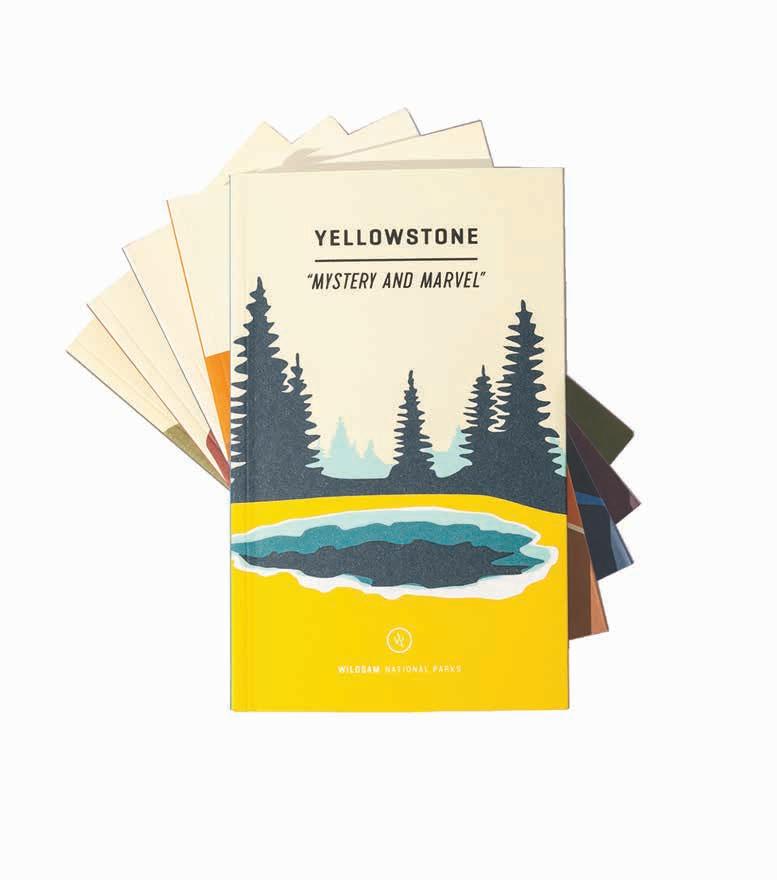



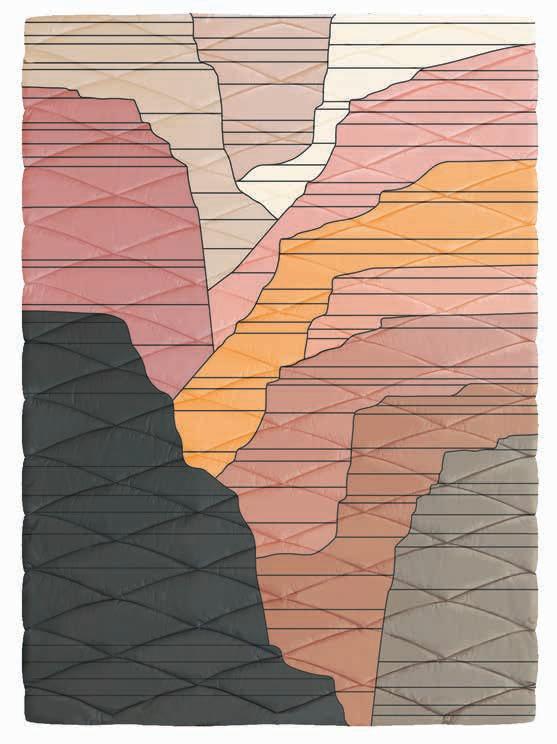


Wildsam’s field guides are a low-fi, literary resource for travelers looking to tap into the wisdom of the rangers, biologists, guides, outfitters, and writers who contribute to this charming, well-designed series of books on national parks, Western cities, and other regions of the U.S. $24; wildsam.com
Consider this bird feeder the fast track to avian obsession. With a four-megapixel wide-angle camera, video and still capabilities, solar panels on its roof, and an AI-supported bird identification app, this feeder will feed any birder’s need to catalog the feathered wildlife in their backyard. $179.99; feathersnap.com
If a clog and a slipper had a baby, this comfortable, shearling-lined leather mule from Hawaiian footwear brand OluKai is super comfy and comes in this festive silver colorway that’s perfect for lounging around the house come the holidays. $140; olukai.com

There’s no easier or cozier way to feed a group of friends and family on a cold winter night than with a hot pot. This set from West Coast Sichuan food legend Fly by Jing comes with everything you need to get the party started: a cheery variable temperature hot pot, chopsticks, spoons, and a savory soup base to get you simmering and communally cooking in style. $130; flybyjing.com
This versatile puffer blanket sports an abstracted gradient graphic of the Grand Canyon, is perfect as a wrap for cozying up by the firepit, and can snap shut to become a minimalist sleeping blanket. Rated for temperatures as low as 50° and made of recycled materials, it’s handsome at home or at the campsite. $99.95; nomadix.co
Located on Willapa Bay, Washington, Ekone is a fifth-generation family-run business that smokes and cans exquisite locally caught seafood. This smoked coho will make a sweet and briny addition to your morning bagel or a holiday tinned fish board. Plus, the cute packaging makes it a stylish stocking stuffer for the pescetarians in your life. $12.50; ekoneseafood.com
This design-minded lamp from Conway Electric was inspired by the cantilevered forms of Frank Lloyd Wright architecture, is made in the U.S. from American components, and boasts USB-C ports, power outlets, and a soft LED light with a progressive dimmer that allows you to change the vibe from Zoom-ready to happy hour, depending on your mood. $300; conwaygoods.com















































Embarking on the open road with your travel trailer is an exciting experience, lled with adventure and the promise of new discoveries. However, ensuring that your journey remains carefree involves more than just planning the perfect route and destination. It involves protecting your travel trailer with insurance customized for you. Here are a few reasons why having insurance for your travel trailer is not just a wise decision, but an essential one.


Peace of mind on the road
Traveling comes with its share of uncertainties, and having insurance for your travel trailer provides you with the peace of mind that you deserve. Whether you’re cruising down the highway or parked at a scenic campsite, knowing that your investment is protected can make your travels even more enjoyable.
Protection against the unexpected Damage to your travel trailer can happen when you least expect it. Comprehensive and collision travel trailer insurance can cover you in case of events that are out of your control, like a tree limb falling on your trailer. Optional Pest Damage ProtectionSM provides coverage for damage from pests such as rats, mice, insects, birds, or other nondomesticated animals.
Coverage for personal belongings
Your travel trailer is not just a mode of transportation; it’s your home on wheels. Optional personal effects coverage can help cover the cost of personal belongings inside the trailer, providing nancial assistance in case of theft or damage.
When auto insurance isn’t enough
Auto insurance generally provides coverage for your travel trailer only when it is connected to your vehicle and may assist in cases where your trailer causes damage to another vehicle. However, it typically does not provide standalone coverage for repairing or replacing your trailer if it sustains damage or is totaled.
You can choose travel trailer insurance options that help cover those expenses and may even offer the bene t of total loss replacement coverage.
When homeowners insurance isn’t enough
Homeowners insurance may provide some coverage for your belongings, but often has limitations when the trailer is off your property. A customized travel trailer insurance policy can ensure that your trailer and belongings are adequately covered.
Liability protection
Accidents involving your travel trailer can also lead to liability issues. Insurance can provide protection against third-party claims, covering medical expenses or property damage that may arise from an incident involving your trailer.
Insuring your travel trailer is not just a precaution; it’s a commitment to a worry-free travel experience. Safeguard your investment, enjoy the journey, and make every moment on the road a memory worth cherishing. Start your adventure with the con dence that comes from knowing your travel trailer is protected against life’s unexpected twists and turns.
Scan to get a quote in as little as 4 minutes

These cleverly compartmentalized areas are created by elevation change and the use of hardscaping, then softened with complementary desert-loving plant material that blends into the surrounding landscape, proving intentional design can maximize enjoyment in even the smallest of spaces.
How a petite 4,000-square-foot desert plot was transformed into a multi-purpose paradise.
Story by KRISTIN GUY

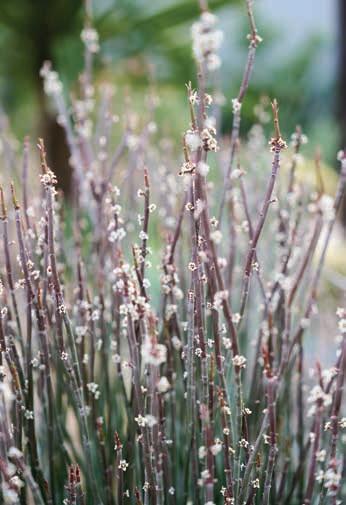

1. Round golden barrel cacti are sprinkled throughout the project to help visually break up hard structural lines and add visual interest.
2. Drought-tolerant grasses, such as Carex, provide architectural interest while being a mess-free choice for pool plantings.
3. Euphorbia resinifera brings a unique texture that adds depth and character to xeriscape gardens while attracting beneficial wildlife.
When designing a small space for maximum enjoyment, it’s challenging to create an effortless flow—especially when the client’s wish list includes a pool, outdoor seating areas, shade, a fire element for the winter season, an outdoor shower, and abundant indigenous landscaping. But the team at Phoenix-based design firm Trueform didn’t even flinch at this request. While it might seem like a tall ask, Todd Briggs and his design team went into the project considering amenities cohesively rather than individually to avoid a potentially disjointed outdoor space. The result? A streamlined sanctuary where all the pieces of relaxation blend together beautifully.
The homeowners insisted on incorporating yuccas and other architectural natives like agave and aloe into the design. Trueform stuck to this initial plant palette as the focal point, with the remainder of landscaping bridging these Sonoran Desert varieties with softer indigenous species, including Desert Milkweed, Native Fairy Duster, Candelilla, and Hop Bush. With a tightly curated plant list placed both as borders and accents, this dialed-in design threads a cohesive narrative throughout the small space without making it feel cluttered. Shade in the desert climate is a necessity, but a commodity, so the team also included complementary desert trees, including Palo Verde and Mesquite. These provide relief from the sun during warmer months but were purposely placed to maximize sun during their deciduous days of winter. Keeping seasonality in mind when choosing planting sites allows for a space to be used all year long.
When it comes to framing outdoor rooms, Trueform strives to connect one space to the other with a hierarchy of needs. With so much happening in one small space, it can help simplify the materials and surfaces by stretching them across the entire plot. Raw concrete was the choice of material for paving and fixed seating walls, an intentional and simple material palette that does not compete with a more eclectic and sculptural plant palette. Beyond the pool area, the seating areas incorporate stabilized decomposed granite, a durable choice for the Sonoran Desert that provides a subtle aesthetic shift and works as a smooth transition between spaces. The shade structure and fire feature use steel, which is then echoed in the steel steps from the pool down into the lower seating area, which also uses decomposed granite. This restraint in material selection with deliberate repetition results in a more serene and contemplative experience.

Keep outdoor spaces organized with intentional details that won’t sacrifice relaxation requests. Trueform’s principal, Todd Briggs, breaks down the individual design pieces that make up this desert paradise.
The homeowners informed us that the original pool in the backyard was oversized for their needs and in an awkward location. The goal was to scale and simplify without dominating the space or being an ornament. The pool is also positioned so it is viewable from the interior of the home, particularly the kitchen and seating areas.

This space was conceptualized as a more intimate garden, scaled for a smaller seating arrangement for two. The backdrop of the fire feature provides a touch of room definition, while the surrounding landscape and overhead canopy of the adjacent Mesquite tree provide a quiet moment in the garden to enjoy a coffee or cocktail with easy access to the master suite.
The placement of the fire feature intentionally reinforces the linear axis of the design, essentially acting as a terminus of the view from the sunken seating garden across the pool and ending with fire. The backdrop of the fire is a rusted steel plate that defines both the pool patio and the smallerscaled seating area.
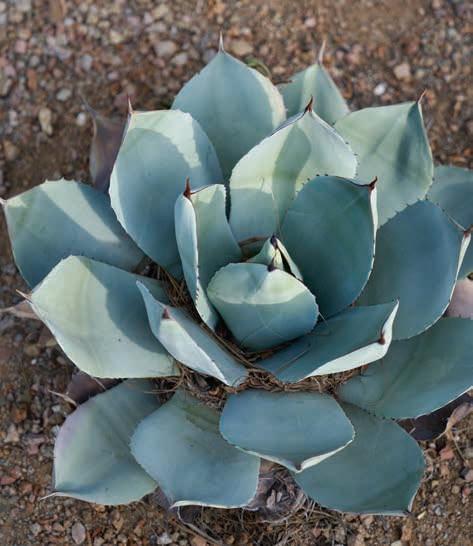


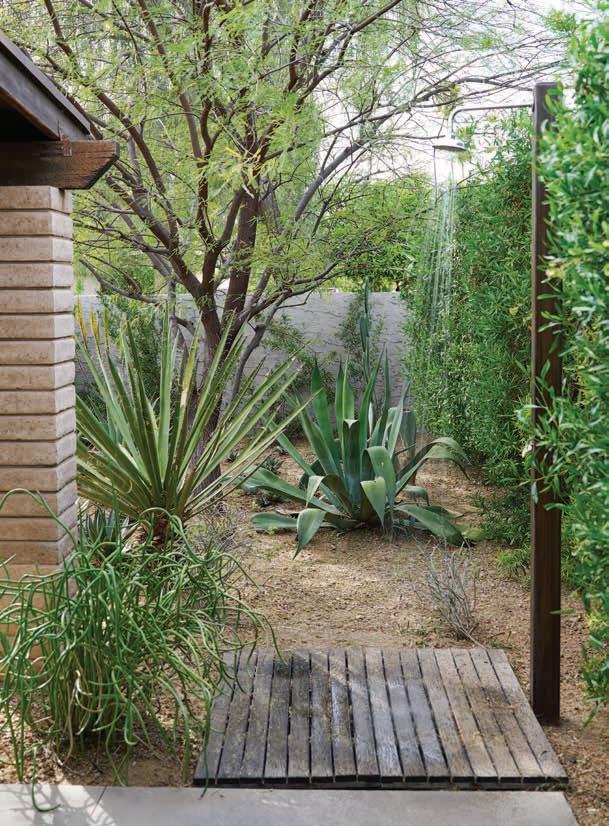
In the desert, it is common for wildlife and humans to seek lower terrain in the hotter times of the year, as it provides cooler temperatures and more shade from larger desert trees. We’ve translated this into a residential setting, carving down into the landscape, which provides an escape and a new perspective. Here, the homeowners can sit in this space with a more intimate connection to the vegetation at eye level along the edges.
This feature is intentionally tucked behind an existing patio cover to be more discreet and private. Plumbing is routed through a square steel tube that matches the posts at the shade structure to give a more minimal look, while the wood decking conceals the small shower pan, which drains into a French drain that deep waters the adjacent Mesquite tree.

A young family puts down deep roots and spreads their adventurous wings from their home base on Maui, a 1,000-square-foot slice of paradise designed for their unique needs.

Nestled in a grove of Cook Island pines, eucalyptus, and rolling green
the Camps’ house lives much larger than its 1,000-square-foot layout. A standing seam metal roof holds up to heavy island rains, and the outdoor living space is sheltered from the wind.
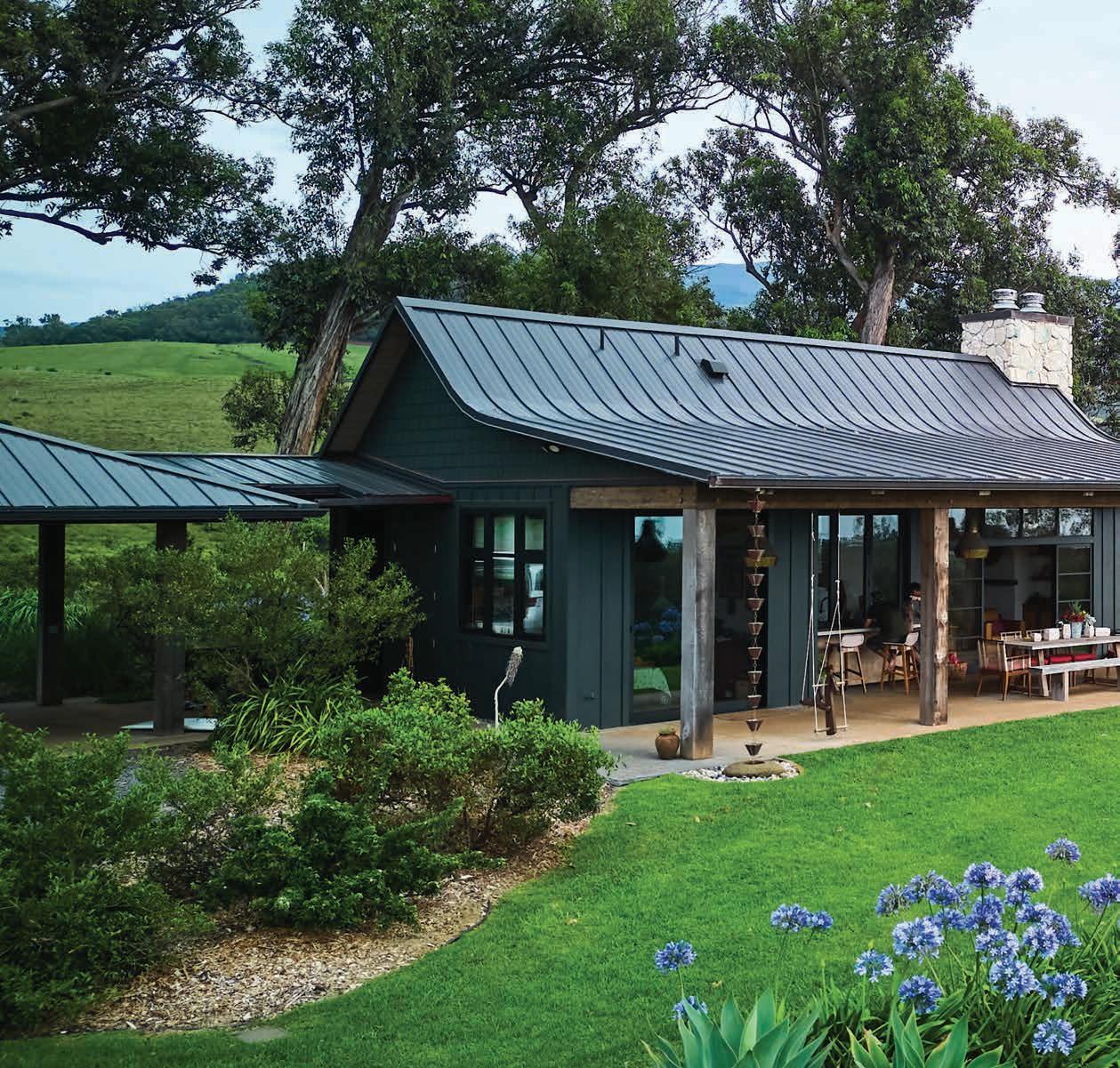
Erica and Bond Camp have the kind of unbridled optimism and adventure-loving spirit that make anything seem possible.
The couple met as students in Colorado and connected over their shared love of surfing, travel, and adventure. They’ve lived in Bali and Thailand, explored Cuba, El Salvador, and Botswana, and, for a time, called a van in New Zealand home. They renovated and ran a ski hostel in Breckenridge. Erica launched a successful swimwear business. Then in 2015, after Bond suffered a traumatic spinal cord injury in a

backcountry skiing accident that left his lower body paralyzed, they surpassed all expectations and prognoses. Erica never left his side. Bond worked hard on his recovery. They married, moved to Maui, had a son, Waylon, and bought a small parcel of pristine land on a larger lot zoned for agricultural use with 360° views of paradise. And then, slowly, over several years, they started to imagine and build their dream house.
“On an ag-zone property on Maui, you can build one house without size restrictions, and then another home
that’s referred to as an Ohana, like a cottage, that’s limited to 1,000 square feet of interior space and unlimited lanai space,” says Bond, explaining the unusual limitations and building codes regulating what they were allowed to construct. “But the climate is so perfect that we’re outside a lot, so it feels like a much bigger house.”
“We were the classic ‘Champagne taste, Bud Light budget’ people,” says Erica, who did not want to compromise on quality finishes like tile, flooring, and fixtures and took her time getting every detail just right

This page: Four seasons of ideal weather and plenty of outdoor dining furniture by Palecek make meals on the lanai an everyday event. Custom lanterns by Christopher Edwards. Opposite, clock-
travel prints by
like Nick Kuchar hang on the walls in Waylon’s room. A muted pink backsplash of clé tile and silky oak custom cabinetry create a warm, earthy palette in the kitchen. Bond and Waylan put in some swing time on the lanai. A carved stone sink adds an organic element to the powder room. Rope-wrapped pendant by Pop & Scott.
during a two-year design process. “Our architect grew up nearby, so he really knew the land and the wind patterns and how to site the house in the perfect spot. He also did a fabulous job making sure there are no dead ends because Bond’s in a wheelchair, and we don’t want anyone’s feet to be run over.”
Once the house was built and the bones were firmly in place, decorating introduced a new set of challenges. Finding a local designer who was game for a job of this scope seemed unlikely. But because defying odds is what the Camps do, it’s no surprise that when Erica cold-called a worldclass Honolulu-based interior designer—Avery Solmssen of Averylily—and asked her to decorate the 1,000-square-foot house they built on farmland surrounded by goat pastures, she said yes.
“When Erica called me, we connected instantly,” says Solmssen, recalling the day when she was first wowed by the Camps’ plentiful charm. “We
both went to school in Boulder, Colorado. We’d both spent time in Botswana and shared a love for African design. We chatted for about an hour, and she immediately felt like an old friend. Then I was like, ‘So you have a 1,000-square-foot home, and you want me to do what?”
Solmssen has spent the last two decades working for major design firms, creating sprawling vacation homes in the Hawaiian Islands. Her signature mix of furniture with classic, modern lines, layered with subtle nods to their tropical environment—like pops of color, handiwork by local craftspeople, and vibrant art—put a sophisticated spin on Aloha style. Then, back in 2020, Lily Kanter, Serena & Lily co-founder, bought a home that Solmssen decorated and requested to meet the designer. The two connected immediately. A year and a half later, Solmssen mentioned to Kanter that she wanted to start her own business. Kanter, ever the enterprising

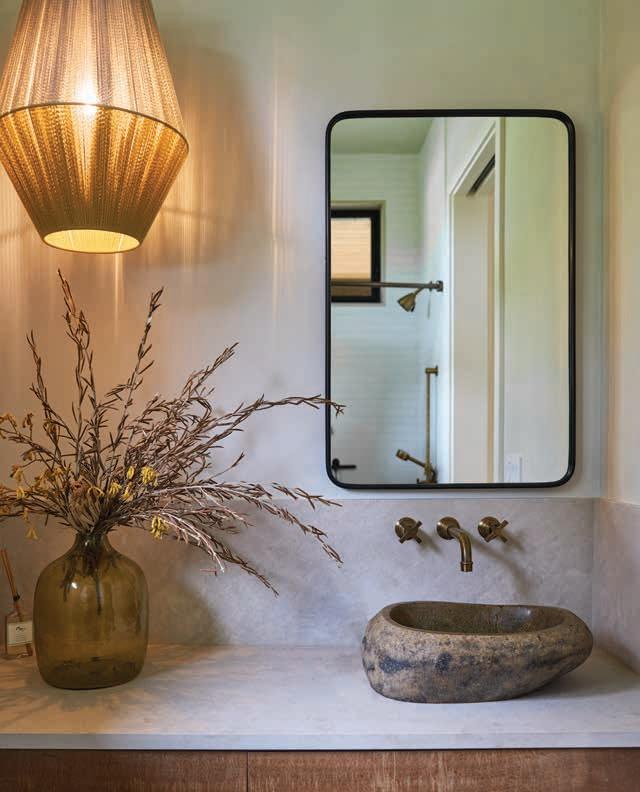



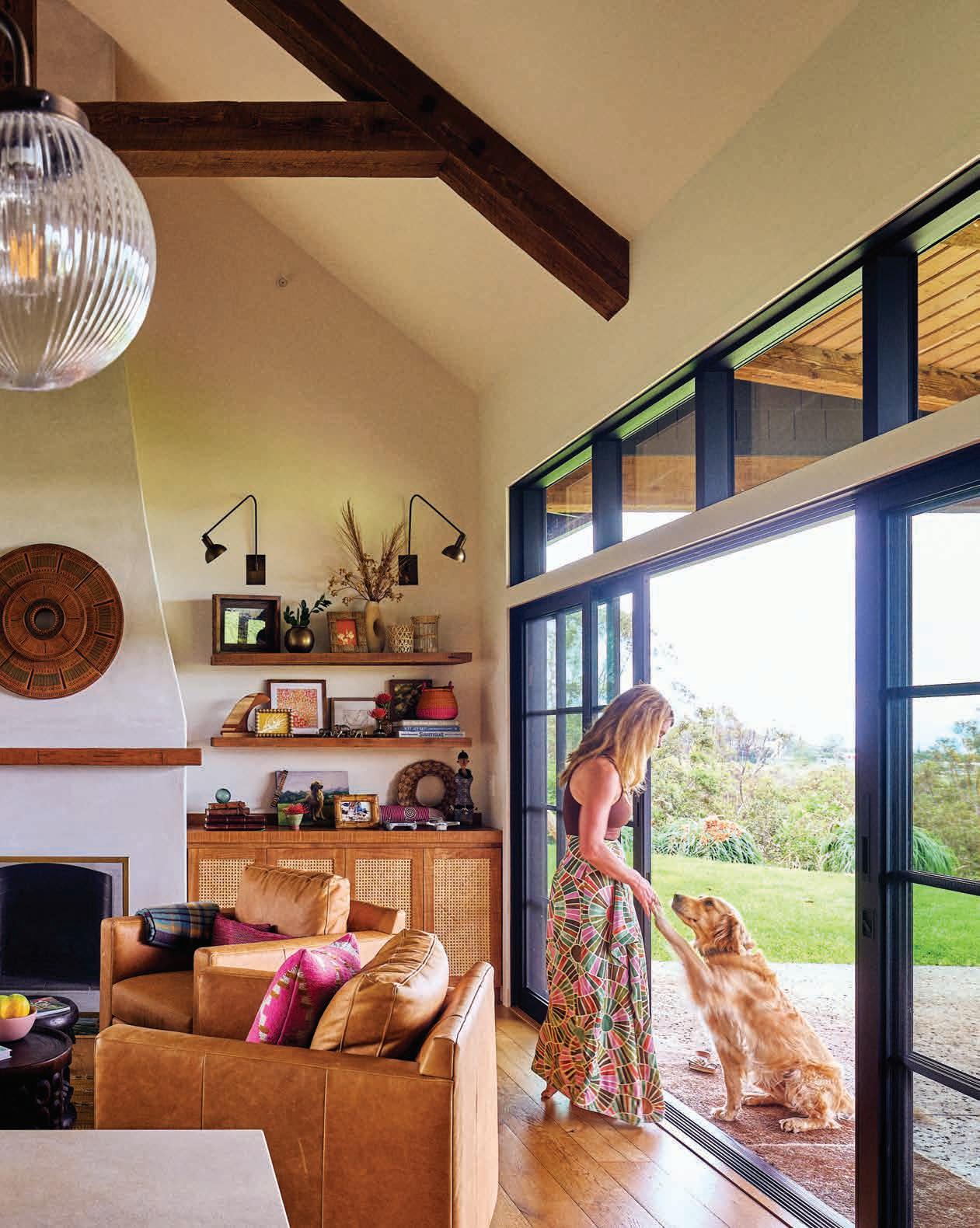
On the advice of designer Avery Solmssen, the Camps opted for four chairs—two leather swivel club chairs from Crate and Barrel, and two from Hollywood at Home—instead of a living room sofa, and they love the flexibility it allows. The pink and brown upholstery fabric is by Elitis. The custom ceramic piece hanging over the fireplace is by Christoper Edwards.

Erica and Bond admire the view from the sauna from Creative Woodcrafting in Averylily robes. The double-sink vanity in the primary bathroom provides plenty of space for Bond to maneuver through the room; tile by Heath Ceramics. Solmssen, left, refers to the Camps, who have become friends, as the “most adventurous” people she knows.



In Waylon’s room, the wallpaper is Wavelength in The Seven Seas color by Abnormals Anonymous, and the bedding is by Averylily. Erica was the first person to buy the brand’s now iconic surfer-print quilt. Solmssen commissioned artist Annie Seaton to stitch together photos of Bond for this custom piece over the bed.

This page: The kitchen windows fold open entirely to the outside, creating the illusion of more space and great entertaining flow. Range, Café Appliances. Opposite: A mix of Euro pillows from Averylily and Zoffany, deep green wall covering by Elitis, a framed botanical print, and a pierced brass hanging lamp bring a hint of African elegance to the tropical primary bedroom.

“I love how we incorporated some unusual design elements that reflect the family and their travels.”
businesswoman, saw an opportunity in the market to develop a brand devoted to elegant island style. The two joined forces, and Averylily—both a design studio and a retailer selling quality home textiles—was born.
“Lily told me never to say no to an opportunity. You never know what’s going to happen. So I went to Maui to see the house, and it was so beautiful,” Solmssen says. “I loved the long driveway and the goats. This house was so personal, and it was fun to play with the scale and take on the challenge of finding furniture that works for Bond that doesn’t compromise on style.”
It’s worth mentioning that the design of the Camps’ home was very subtly adjusted to accommodate his wheelchair. Thoughtful touches, like a living room designed with four chairs facing each other instead of a standard sofa, put everyone in the conversation area on equal ground. A spacious outdoor shower—and ideal year-round weather— makes bathing a breeze. There’s plenty of clearance through the hallways, and all of the door thresholds are flush with the floor. Under-cabinet storage in the kitchen allows for easy access, and a kitchen island with generous space around it
means everyone can move easily around it and not get logjammed in front of the refrigerator. A pass-through window in the kitchen also makes entertaining a breeze.
“I love having people over. I’m always hosting showers and parties, and this house is perfect for that. When the doors are open, there’s so much space.”
Despite the appearance of those wide-open landscapes, the Camps are also just a short drive into town and have figured out the best possible combination of sea and land, surf and sky.
“Waylon’s school is just six minutes away, and we can get to the surf in 15,” says Erica. “So we really have the best situation with plenty of land and still feeling connected to the community.”
Solmssen has seen her fair share of island escapes, but she has a special affection for the Camp family, their inspired worldview, and their beautiful bungalow.
“I love how we incorporated some unusual design elements that reflect the family and their travels,” she says. “They’re some of the most active people I’ve ever met. Bond’s accident hasn’t slowed them down at all.”
Slow down with the season and pay attention to the small details that will make a difference in the months ahead.
Story by KRISTIN GUY
It’s bare-root season and the perfect time to add flavor to your landscape. While stone fruit, persimmons, and pomegranates are all fantastic fruiting choices to plant now, consider adding a heat- and drought-tolerant jujube, which looks prolific in the garden while providing an abundance of small, sweet, apple-like flavored fruits that can be enjoyed fresh or dried
Roses should be planted in December when nursery selection is at its best, but avoid selecting any pots in a sunny location, as they might have premature shoots. To avoid dried-out or damaged roots, plant all bare-root stock as soon as possible. If inclement weather should put a halt to your transplanting, “heel in” the roots temporarily in a shady location with damp sand or compost
Flowering native perennials, such as Golden Yarrow (Eriophyllum confertiflorum), Foothill
Penstemon (Penstemon heterophyllus), Desert Globemallow (Sphaeralcea ambigua), and Oregon Grape (Mahonia aquifolium) can all be planted later this season while providing winter color and vital food sources for pollinators
Hellebores are beginning to blossom and make for incredible winter cut flower bouquets. For long-lasting blooms, wait until the flowers mature and pollen has dropped from the anthers. Cut stems at an angle and condition them by dipping them into boiling hot water for 30 seconds before placing into a vase with cool water
Mix up your usual holiday evergreen arrangements and prune a few clippings from your native garden. For branches with berries, try using California Holly (Toyon, Heteromeles arbutifolia), Pacific Madrone (Arbutus menziesii), and Red Osier Dogwood (Cornus sericea), which all look lovely in wreaths. For
cones and seed pods, look for Sugar Pine (Pinus lambertiana), Western Hemlock (Tsuga heterophylla), and California Buckeye (Aesculus californica). Even the decorative leaves of Salal (Gaultheria shallon) or Evergreen Huckleberry (Vaccinium ovatum) would make for a unique garland
Looking to expand your strawberry patch?

Transplant runners by gently pulling crowns apart by hand or with a garden knife. To plant, simply soak roots for four to six hours and place in loose, damp soil, making sure it covers all roots but does not touch the bottom of the crown. Try incorporating native varieties, such as Fragaria chiloensis, Fragaria vesca, or Fragaria virginiana, which all make for incredible ground cover alternatives in shady, low-traffic areas
Darker days call for adding drama and more visibility to the garden. Consider adding a touch of whimsy through lighting with pathway spots, lanterns, or even cafe lights, which can all be easily installed—and with so many solar options, no electrical outlets needed
With deciduous trees losing their leaves, take note of how structural elements could

define your garden space. Adding arbors, trellises, or even sculptures into your space can help define new entertaining spaces while adding visual interest throughout the year.
Winter is the perfect time to offer protection to our feathered friends. Level up your bird and wildlife gardens with new nest boxes and roosting sites. While birdhouses are easy
options to install for small species like chickadees, titmice, bluebirds, and wrens, don’t forget about owl boxes that can be added if you have trees that allow for a 15- to 30-foot installation height. While native shrubs are the ultimate shelter for wildlife, if selecting roosting pockets, choose ones made of woven natural grass fibers that will be more appealing to birds while offering a natural yet stylish look for your garden.
Don’t be surprised by an overnight freeze. Check in on your garden supplies and make sure you have burlap or frost blanket on hand for additional temporary protection. Bubble wrap from a recent delivery can even work in a pinch. Most importantly, remember that cold weather protection is temporary, and any wrap should be removed after weather events and not left on all winter to avoid disease.
Wonder of the Woodlands author Françoise Weeks proves there are no rules when it comes to foraging for winter filigree. Pinecones, lichen, and dried seaweed coexist as horticulture highlights in this forest-made fixture. They can also be constructed to live both indoors and out—opening the door for unexpected and creative decor opportunities this holiday season.
Portland-based author Françoise Weeks has mastered the art of creating with nature. In her latest book, Wonder of the Woodlands, she shows you how to build unique arrangements that last far longer than a vase of cut flowers.

Once a flower-focused adventurer, Françoise Weeks realized she never really had paid much attention to the different barks, mosses, or seed pods that litter sidewalks on her hikes through her neighborhood and surrounding forest. Making note of the smaller details in nature created a shift in her that she now calls woodland design. “As soon as I started to focus on the beauty and unique characteristics of all these elements, curiosity drove me to design with these newly found treasures,” she explains. “A new world of possibilities in design opened. I discovered that there were so many different variations of these elements—from textures to colors to shapes—and it was a delight to experiment with them all.”
Here, Françoise shares her tips for unlocking inspiration while walking under the trees this winter. She hopes everyone will start seeing Mother Nature through different eyes and discover the many natural gems we can design with.
Designing with natural elements is quite different from designing with flowers, but Françoise encourages beginners to go in with an open mind, as the mechanics and techniques are similar. Because locally foraged materials can differ so much from region to region, it’s important to take the time to discover what’s available around you and explore with an open curiosity for new ideas. Paying attention to the smallest of details will spark a starting point for your own nature-driven expressions. When collecting, don’t feel pressured to have a fully fleshed-out idea of what the finished design will look like, and be open to intuitive design based on the available materials.
Françoise lives in an old neighborhood where the streets are lined with very mature trees, and she makes it a habit to go collecting after windstorms. She suggests bringing a bag and a pair of shears on walks to gather seed pods, pieces of moss and lichens, and even branches that have freshly fallen on the sidewalks. Taking note of favorite materials is important for future collecting and projects, but she urges one should always be mindful when foraging and to only source sustainably.
When it comes to the holidays, woodland wreaths and framed woodland scapes are some of Françoise’s favorite projects. Hellebores and snowdrops can be placed in water tubes to give creations a pop of fresh flowers—just use pieces of moss or bark to cover any arrangement mechanics. Her favorite seasonal textures include mixing a variety of evergreens, holly, pinecones, dried pomegranates, dehydrated persimmon and orange slices, cinnamon sticks, walnuts, and hazelnuts with foraged bark and lichen-covered branches.
Winter months might make finding diverse materials challenging, so it’s important to collect seed pods and things of that nature during seasons when they are plentiful. During the winter, Françoise relies more on buying plants or using materials that have been dried in a flower press, such as maidenhair ferns and rex begonia leaves. No matter what nature has provided for you, there is much creativity to be had. In fact, the woodland look is not reserved just for centerpieces, wall hangings, or structural designs: The holiday season is an excellent opportunity to create and accessorize with botanical jewelry, headpieces, or small woodland flair that can be worn on shoes or bags.
You don’t have to live within walking distance of an enchanted forest to pull off these creations. Mosses, lichens, bark, branches, seed pods, mushrooms, and even ferns all can be purchased online. Françoise also advises readers to lean into other non-woodland plant materials, such as succulents and tillandsias, which offer such interesting textures and shapes and make for an unexpected arrangement. Don’t be afraid to embrace your own region’s set of treasures, where woodland design consists of a variety of textures and very few (if any) flowers, exploring what is locally available to you makes your designs both sustainable and unique.


FROM THE FOREST FLOOR TO YOUR FRONT DOOR, FRANÇOISE WEEKS SHARES HER TIPS ON HOW TO MAKE THE PERFECT WOODLAND WREATH.
For more natural design inspiration, be sure to pick up a copy of Wonder of the Woodlands: The Art of Seeing and Creating with Nature. $30; Clarkson Potter.
I love making these woodland wreaths and like to use elements that do not require a water source so they can be enjoyed for many months. You can use pieces of bark, interesting branches, or small pieces of wood, and display a variety of seed pods from trees, shrubs, annuals, or perennials during the fall. Also, incorporate any interesting finds from the garden or flower market that will still look nice when dried.
MATERIALS:
16-inch wreath frames
Paddle wire
Cold and hot glue
Foraged or store-bought seed pods and greenery
1. Using paddle wire, attach a moss base to the frame by winding wire around the moss every inch or so. If necessary, use cold glue to attach any straggling pieces. Then, use a glue gun to attach the decorations.
2. This wreath contains moss, bark, lichen, dried mushrooms, a variety of seed pods (eucalyptus, Cardiocrinum, devil’s claw, screwbean mesquite), acorns, dried ferns, pinecones, succulents, and cacti. I like to place the smaller elements before gluing them so I can change their position if need be; I often do this in sections.
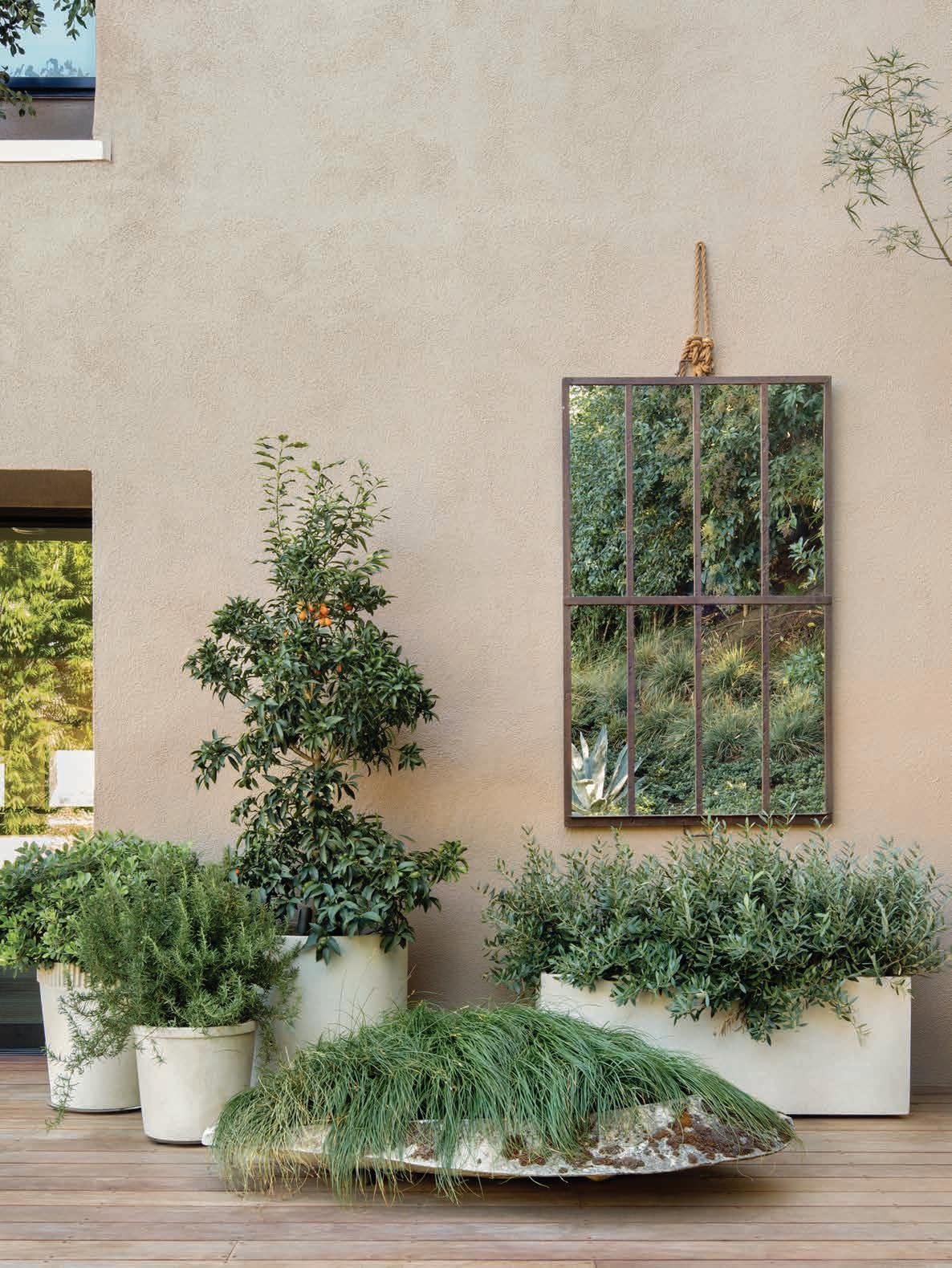
Stephen Block, the Los Angeles-based celebrity landscape designer and antiques dealer behind Inner Gardens, has a signature style guided by the principle of wabi-sabi. Here he shares his top tips on how to embrace vintage decor and greenery to curate extraordinary garden spaces with a focus on containers and structural design elements.
When it comes to arranging plantscapes in pots, Stephen likes to think of containers as “jewelry” for the garden. Quantity is not the goal, and he advises that a correctly placed planter or object in the garden helps you navigate the garden and provides focal points along the way. Keeping scale in mind is a must, and he urges you to go big. Stephen says people considering using a 15-gallon plant in an 18-inch planter should go for a 24-inch box tree in a 25-inch planter. A few larger trees rather than a small group of plants will have a greater impact on the space.
The Inner Gardens team uses its signature planters, which provide a patina to the garden. Look for ceramics that look like they have been in the gardens for years. Stephen sources antique planters from France, Spain, and Italy that offer unique textures with centuries-old terra-cotta and midcentury fiber cement. But you can always go with good old concrete as a solid modern staple for any style garden. For placement, larger rectangular containers should be positioned in the back of your grouping, with shorter containers situated in the front. If using round vessels, place the tallest planters in the middle, with shorter options around the sides.
For a statement ceramic planter, Stephen prefers to plant with a minimal variety of plant types and suggests using the same plant material as mass plantings to offer more drama. Make sure to use larger plants than you think in order to gain the greatest impact. Selecting two to three large plants is always more dynamic than ten small plants. Stephen says a good specimen plant is not necessarily a specific size, color, or leaf shape, but rather
a plant that moves your heart and makes you smile. Opt for unusual containers with unusual plants. A favorite pairing is Brachychiton rupestris in vintage low bowls. Architectural plantings such as Pachira aquatica and Cussonia spicata also work beautifully, showcasing more trunk and less leaves, in low style bowls.
Each garden calls for a unique vision, but your heart is what really tells the personal story. Always go into any plant selection with knowledge about your local climate, the ins and outs of sun versus shade, and which plants will reasonably survive your particular conditions because no matter how much you love it, the wrong plant in the wrong spot will always struggle and guarantees a frustrating experience.
Not big with the outdoor square footage? Ceramicscaping works inside or on tabletops. Architecturally structured plants generally require a bit of light, so location is really your only limit. Make sure any plants are placed in as direct a light source as possible. For interior installations, try using Ginger Ficus, Fockea, Jade, Brachychiton, or Cussonia.
Leaning into the art of wabisabi leads Stephen to select materials that show the roughness, texture, and age of the piece to provide a counterpoint to the surrounding garden. Finding an object with a few cracks or breaks is not a bad thing, says Stephen. He admits that if a container is too perfect, it won’t have the same intrigue. Patina is critical—look for objects and pots with moss or lichen growing on them for added character. Most importantly, always think outside the box. You don’t have to score pricey antiques to achieve this look: Find an old bucket or something falling apart slightly, and just go for it.


How the creative team behind landscape design and home decor powerhouse Rolling Greens trades out traditional boughs for botanicals.
Story by KRISTIN GUY


Go maximalist with your holiday hang-ups and consider oversize faux wreaths that can be dressed up and dazzling with different decor, allowing you to swap in new styles each holiday season.

If there’s one place I like to lose track of time in,
especially around the holidays, it’s any of the four locations of Los Angeles-based nursery and home decor mecca Rolling Greens. Every nook, shelf, tabletop, and beautiful basket is brimming with stunning decor and pottery begging to come home with you. Shopping spree aside, what I might love even more than filling my cart with new
beautiful pieces is the inspiration I get from how perfectly the creative team integrates the nursery’s plant offerings into the mix. They curate a botanically filled wonderland that evokes a polished yet casual sense of style that further convinces us that houseplants are indeed an integral part of interior design.
While pines are a seasonal staple, many of us wonder if it’s possible to style our existing collection
of potted pretties to lean into more merriment for the holidays. While tying a bow around any ceramic pot is a great place to start, Rolling Greens co-founder Greg Salmeri and creative director Raychel Walton have quite a few tricks up their sleeves when it comes to combining festive with fronds. Here, they share their retail design secrets, masterful styling prowess, and genius use of greenery that’s sure to have us all decking the halls with houseplant happiness this season.

Scarlet Flame Caladium and Variegated Hoya Carnosa paired with ferns and moss make for unexpected and festive foliage that will last into the new year and beyond.

Start with these styling suggestions when treating houseplants like holiday decor:
Identify the areas in your space that you would love to dress up with holiday decor. Keep in mind that this decor is temporary, which gives you license to incorporate whimsy and your over-the-top ideas because it’s only there for a few weeks.
When choosing plants, make sure they accent the colors in your decor.
Select containers that disappear into the background so that the focus stays on the decor and plant material .
We’re always looking for new ways to restyle and revive a space with existing plants, and the holidays are no exception. The Rolling Greens team suggests adding varieties into the mix, such as Sunset Leucadendron, staghorn ferns, pink fittonia, plectranthus platinum, acacia, and begonias, which offer sage or rosy hues that aren’t on-the-nose-holiday.
When arranging groupings of pottery and plant material, remember to use odd numbers and different heights to make an interesting statement.
Remember the five senses and try to incorporate them into your designs. This will create an immersive experience for you and your guests!
Need a place to start?
Try adding a beautiful velvet ribbon bow tied around the container, or arrange ornaments, small pinecones, or gilded leaves and branches into the container and plant branches.

Completely forgoing the traditional Christmas tree might be a no-go for most, but there are many other pine alternatives to consider showcasing during the season. Try incorporating rosemary, olive, lemon cypress, or lavender topiaries into your designs. Rolling Green’s favorites include potted
cypress, boxwood or topiaries, especially when lit with a string of lights for an elevated entryway. Styling any of these in aged or vintage terra-cotta is a great way to pop the plant material, particularly when adding topdressings like Spanish moss or jade-colored rocks to enhance the look. Additionally, succulents
Go full tilt on texture when pairing unique evergreens with embossed pottery, and lean into terra-cotta that’s either fluted or scalloped for a sophisticated spin.
are an easy-to-care-for plant that creates a more architectural look. Succulents aren’t just for pots! Use them to add interest to garlands and wreaths. The Rolling Greens team likes to complement freshly cut succulents with faux staghorn fern and faux Dallas fern for a surprising and long-lasting mix.

No mantle, no problem! Bookshelves and tiered nooks also make for happy holiday moments. If they’re not positioned in the room as your main focal point, the team at Rolling Greens suggests not overdoing it. Instead, keep it stylish and simple while allowing for negative space and highlighting
each piece as a beautiful little spotlight all on its own. When adding botanicals to the mix, choose complementary containers that are more visually interesting than the plants, especially if framing your scene with garland. The team encourages you to continue creativity on these boughs and choose
unexpected pieces or objects to add to your garland, such as naturally shed antlers, faux berries and fruit, live eucalyptus, dried palm fronds, or assorted sizes of pinecones. If using ornaments, opt for colored translucent glass ornaments, which accent the decor while reflecting any lighting.

‘Tis the season to relieve faux plants of their bad reputation. Yes, they’re perfect for spaces with low light, but they can also be incorporated anywhere in your home. With so many more options for real-looking botanicals on the market, think of artificial greenery no differently than you would your ornaments and other holiday decor, which can be carefully packed away and reused each holiday season. The key to a lifelike faux planting or tree is the manipulation of the leaves and stems to emulate the true growth pattern of living plants. Topdressing is also important, so treat your faux features like the real deal and add moss or beautiful pebbles to their containers. When it comes to selecting the right kind of faux plants, the Rolling Greens team suggests stylish staples, such as garlands, pine branches, succulents in deeper reds and purples, wreaths, staghorns, and gilded leaves or berries. Look for details in stem texture, leaf color, and plant growth patterns to ensure the best selection. To style, faux plants should always remain in the background, providing a great base structure from which to build your design that you can use year after year. If weaving in live material, be sure to give those plants center stage, and don’t forget to spritz weekly so that it doesn’t dry out.
Taking table-scaping to the next level, the team at Rolling Greens integrates plants plate-side with an incredible living runner planted directly into the center of the wood slab. This stunning spread showcases perfect plant styling and uses a mix of leaf sizes and form to thoughtfully achieve playful texture and elegance. Here, the team used a combination of maidenhair fern, staghorn fern, trailing rosemary, Dallas fern, variegated ivy, blue star fern, hoya Hindu rope, and picea glauca.
Want to recreate this look using potted plants?
The team suggests taking multiple pots of varying sizes, starting with the largest centerpiece in the middle. Design arrangements in low trough-style vessels and place them along the center of the table, adding garland, branches, moss, or rocks to help disguise the vessel edges. For extra drama, try hanging moss balls and oversized kokedamas (Japanese mosswrapped plants) accented with tillandsia and purple-hued succulents for an unexpected aerial arrangement. If there’s one thing we’ve learned from the creative minds behind Rolling Greens, it’s that there are no rules and no green thumbs needed this holiday, just a bit of imagination and a playful love of plants.

The holiday program at Rolling Greens requires a tremendous amount of preplanning and expertise, and the creative team admits a lot of ideas come from the previous year’s “should haves,” proving you should always revisit design ideas that speak to your heart, no matter the trends. If you’ve ever had the pleasure to walk through any of its retail outlets, you know the amount of care and love that goes not only into the sourcing of unique products but also into the masterful displays that showcase them. Even though Rolling Greens has done all the beauty hunting for you, they want everyone to feel empowered when styling their treasures with confidence back home and offer these five steps to get started.
1
2 3 4 5
Select decor colors that inspire you and are an aesthetic complement to the space, even if it’s monotone.
Select plant material that adds structural interest to the space, whether it is soft tropical leaves or hardedged cacti.
Do not be afraid to incorporate faux into the mix. While living materials breathe freshness into a space, quality faux pieces can create a wonderful foundation.
Incorporate scent into every display with fragrant pine, cinnamon sticks, rosemary, or herbs. Level that up for dinner parties with fragrant flowers like ‘Casa Blanca’ lilies and tuberoses.
When in doubt, invest in vintage pieces. A unique container paired with a smaller Christmas tree and a trove of hand-selected ornaments saves a lot of work and time and can be reused with a favorite houseplant when the season is over.

ROLLING GREENS SHARES ITS HOLIDAY TREND FORECAST WITH 5 DAZZLING DECOR IDEAS + THE PLANT PAIRINGS THAT WILL BRING THEM TO LIFE.
GET THE LOOK
Rustic turned refined, using French Anduze pots and Willy Guhl silhouettes makes for an eclectic styling of deep browns, patinated metals, and touches of tropical plants.
PLANT PALETTE
Palm, begonia, bird of paradise, phoenix roebelenii palm, philodendron monstera, Dallas fern.
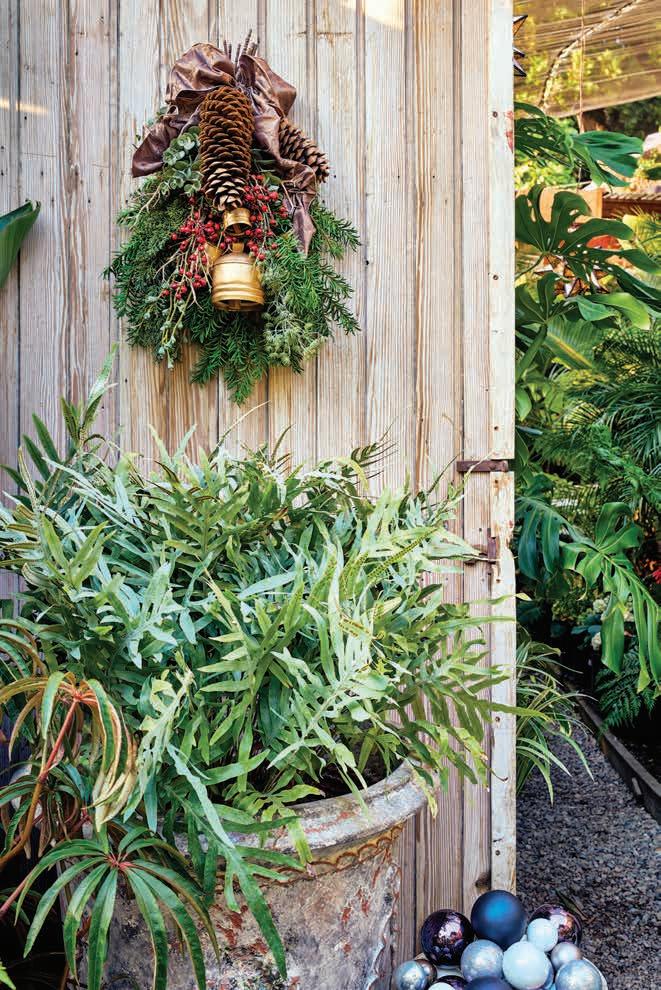

GET THE LOOK
Mix complementary shades of pinks and plums with bronze ornaments for a color-drenched, gem-hued display. Perfect for a table setting for accenting a buffet or entry console, this is a look that begs for textiles and layered drama.
PLANT PALETTE
Leucadendron, staghorn ferns, pine, cedar, mandevilla, fittonia, plectranthus platinum.

Peach ceramics might be an unexpected choice to integrate outdoors for a holiday entryway or patio. However, terra-cotta pottery paired with green ceramics and laced with driftwood pieces, beautiful jade stones, and ornaments in blush or champagne tones is the classy cheer we needed.
Olives, various cacti, assorted pines and cedars, dracaena draco, dracaena marginata, or acacia.
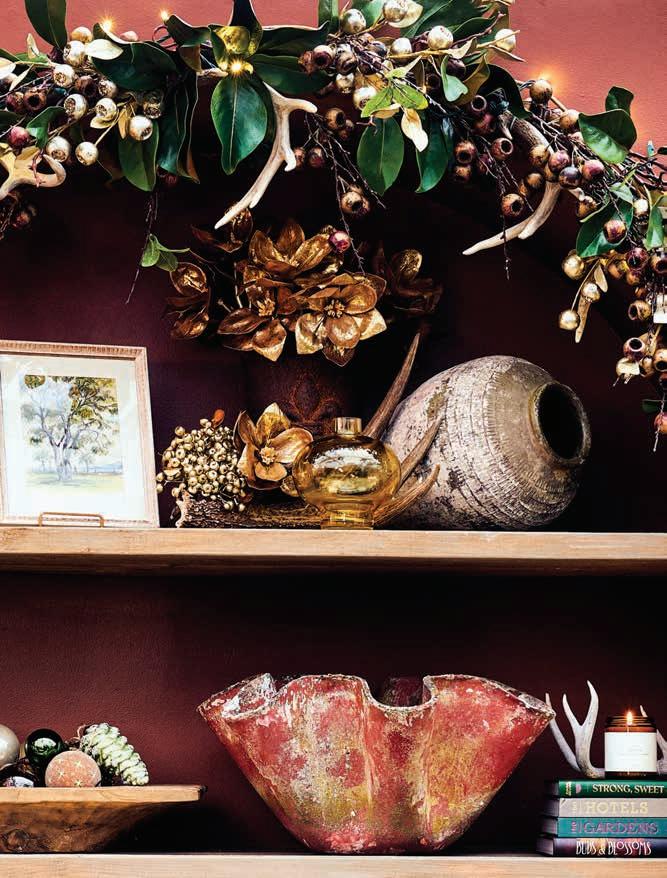
GET THE LOOK
Naturally mossed terra-cotta pottery, such as Campo de’ Fiori, is the key to this architectural pine plant palette. Play with scalloped and uniquely shaped vessels, and mimic those lines with both translucent and opaque green glass ornaments in multiple sizes and in different shades.
PLANT PALETTE
Norfolk pines, rosemary, lemon cypress topiaries, and even bonsai.
GET THE LOOK
More chic than kitsch, try curated vignettes of vintage decor pieces, such as old books, wooden dough bowls full of ornaments, naturally shed antlers, antique picture frames, and taper candles. Stick to a monotone color palette of rusts and warm tones, and frame these moments with faux-lit garland to showcase your styling.
PLANT PALETTE
Button ferns, peperomia, faux garland like magnolia.



A sustainable alternative to tropical hardwoods, redwood is grown to the highest environmental standards in the world and imparts natural beauty and warmth to residential structures. Available certified to the standards of the Forest Stewardship Council® (FSC® C013133). Visit GetRedwood.com to learn more.

Give the gift of greenery this season by creating your own Japanese moss balls that can be customized with a number of statement plants and displayed on stones, saucers, or even hung for a dramatically different winter display.
SUPPLIES:
1 4 to 6-inch Staghorn fern
Sphagnum moss
Organic potting soil
Approximately 14 square inches of sheet moss
Water
Jute-covered wire or twine
Shallow bucket
Gloves
Decorative ribbon for gifting
TECHNIQUE
1. Mix together equal parts soil and Sphagnum moss with water until you reach the desired consistency of thick paste.
2. Remove the plant from its grow pot and gently release the soil from its root system.
3. Lay the plant on one side and form a half-ball with muddy paste, covering all exposed roots.
4. While holding that halfsphere in one hand, scoop additional mud paste onto the other side, creating a full sphere of root coverage. Squeeze out extra moisture as you go and create the roundest shape as possible.
5. Place the mud ball in the center of the sheet moss and pull up all sides around your kokedama ball.
6. Using wire or twine, weave from the “neck” of the kokedama, wrapping underneath and back around until sheet moss is held into place.
7. Once your wrap is complete, connect the twine to the piece you began with, secure with a knot, and trim the excess.
Submerge kokedama ball briefly in water weekly to keep moss damp and plant roots hydrated. Plant may need to be rewrapped with more soil and moss every 1 to 3 years, depending on the variety used.
Anthurium, Caladium, Dracaena, Pothos, Philodendron, Ivy Peperomia, Peace Lily, Norfolk Island Pine, and most ferns. Try integrating air plants and succulents onto the sides of moss balls for a more maximalist display.

































From side dish to star component, Erin Alderson inspires us to dive into a flavorforward world of dried ingredients.
Story by KRISTIN GUY

When it comes to navigating the depths of your kitchen cabinets, you might feel more confused than inspired. To help remedy this pantry paralysis, vegetarian cook and author Erin Alderson takes us on a deliciously delightful adventure in her new The Yearlong Pantry: Bright, Bold Vegetarian Recipes to Transform Everyday Staples (Hardie Grant; $35), in which pantry staples become a playground of plant-based possibilities. Equal parts experimentation guide and cookbook, Alderson gives grains, legumes, nuts, and seeds a bit of seasonal wonder with a Californiainspired twist.
Erin’s website Naturallyella.com and her self-published zine Cook Casual turned me on to her diverse palate, unexpected combinations, and unique layering of ingredients. Her recipes inspire me to both use and preserve vegetables fresh from the garden while incorporating forgotten pantry staples into my cooking in new ways.

The Yearlong Pantry was created to expand the familiarity of flavor profiles, encouraging home cooks to try new ingredients. Erin’s hope is to encourage people to think beyond the obvious and to move side dishes to center stage, grill beans, pickle grains, and turn nuts into creamy dips! This cookbook proves that the more you play and explore, the more you’re able to build your pantry into an arsenal that’s bold and not boring. Here, Erin shares a few radiant recipes perfect for winter that will have you reimagining your stockpile of dry goods on your way to building pantry perfection.

In the realm of fermented foods, especially grain- and soybean-based ones, gochujang is one product that has Erin’s heart. The balance of sweet, savory, and heat is a winning combination. Perfect for satisfying a craving for something fresh-feeling during the cooler months.
SERVES 4
PICKLED RED ONIONS:
½ small red onion, peeled and thinly sliced
2 Tbsp. rice vinegar
½ tsp. kosher salt
CRISPY OVEN CAULIFLOWER:
1 lb. cauliflower florets
2 Tbsp. avocado oil
2 Tbsp. cornstarch
2 Tbsp. potato starch
1 tsp. kosher salt
GOCHUJANG-BUTTER SAUCE:
¼ cup unsalted butter
¼ cup gochujang
2 Tbsp. honey or maple syrup
2 tsp. rice vinegar
½ tsp. kosher salt
1 heaping Tbsp. white sesame seeds, toasted WRAPS:
10 to 12 large butter lettuce leaves
2 cups cooked pearled barley, slightly cooled
½ cup fresh cilantro leaves, coarsely chopped
1. Preheat the oven to 425°F.
2. Make the pickled onions: Combine the red onion, vinegar, and kosher salt in a bowl; set aside.
3. Prepare the cauliflower: Put the cauliflower florets on a sheet pan, then toss with the avocado oil, cornstarch, potato starch, and salt. Arrange in a single layer. Bake, stirring every 10 minutes or so, until the cauliflower is golden and crisp, 25 to 30 minutes.
4. Make the sauce: Melt the butter in a medium skillet over medium-low heat. Whisk in the gochujang, honey, vinegar, and salt. Increase the heat to medium and whisk until the mixture bubbles and thickens slightly. Turn off the heat and stir in the sesame seeds. Add the crispy cauliflower and stir to coat.
5. Assemble the wraps: Lay the lettuce leaves on a large serving platter. Divide the barley among the leaves, followed by the cauliflower. Finish each wrap with cilantro and pickled onions.

These croquettes were inspired by a love for happy hour and the fresh Syrian oregano Erin grows and uses to make her own za’atar blend.
SERVES 4
CROQUETTES:
½ cup dried red lentils
1 ¼ cups water
2 garlic cloves, minced
3 Tbsp. all-purpose or soft wheat flour
1 Tbsp. nutritional yeast
¾ tsp. kosher salt
2 large eggs, divided Avocado or other neutral high-heat oil, for frying
1 cup Japanese-style panko bread crumbs
½ tsp. kosher salt
ZA’ATAR:
3 Tbsp. dried za’atar
1 Tbsp. sumac
1 Tbsp. white sesame seeds, toasted
½ tsp. kosher salt
FOR SERVING:
¾ cup labneh or Greek yogurt
Olive oil
1. Make the croquettes: Place the lentils and water in a small pot. Cover and cook over medium-low heat for 15 to 20 minutes, until the lentils begin to break down. Remove from the heat and let cool.
2. While the lentils are cooling, line an 8 by 4-inch (20 cm by 10 cm) loaf pan with parchment paper.
3. When the lentils are cool, add the garlic, flour, nutritional yeast, salt, and 1 egg.
Stir to combine, mashing the lentils together as you mix. Transfer to the prepared pan and smooth the top. Place in the freezer and chill until mostly frozen, at least 3 to 4 hours.
4. Make the za’atar: Using a mortar and pestle, crush the dried za’atar with the sumac and salt. Add the toasted sesame seeds and partially grind until some of the sesame seeds are in pieces. Set aside.
5. Cook the croquettes: Heat 2 inches of avocado oil in a deep, heavy saucepan to 325°F. Have a medium bowl and the za’atar ready to use.
6. Remove the lentils from the freezer, lift out of the pan, and cut into eight 4-inch long bars. If needed, let the lentils sit at room temperature for a few minutes, cut, then return to the freezer until the oil is hot.
7. Whisk the remaining egg in a small bowl and combine the panko and salt in a separate bowl. Working with a few croquettes at a time, roll in the egg and then the panko. Place directly in the hot oil and fry until the panko is golden brown and crisp, 3 to 4 minutes.
8. Using a skimmer or slotted spoon, remove the croquettes from the oil, tapping off any excess oil, and place in a medium bowl. Sprinkle and toss with a bit of the za’atar, then repeat with remaining croquettes.
9. To serve: Spread the labneh in a shallow bowl or platter and drizzle with olive oil. Arrange the croquettes on top and sprinkle with any remaining za’atar before serving.

Erin finds squash to be one of the “meatier” vegetables that can really hold its own in a rich sauce. Her favorite combination is kabocha squash with a hearty mole. While a truly good mole is a labor of love and time, this Pipián Rojo is an adjacent, flavor-packed sauce that really shows the power of seeds but is not as technically involved. SERVES 4
PIPIÁN ROJO:
2 dried mild chiles, such as New Mexico
1 dried medium chile, such as guajillo
1 dried mild smoky chile, such as ancho
¼ cup raw pepitas
1 Tbsp. white sesame seeds
½ cinnamon stick, or ½ tsp. ground cinnamon
2 allspice berries, or ¼ tsp. ground allspice
½ tsp. cumin seeds, or ½ tsp. ground
½ large yellow onion
1 Tbsp. avocado oil
3 garlic cloves, smashed
2 Tbsp. tomato paste, divided
1 cup vegetable broth, plus more as needed
3 Tbsp. raisins
½ tsp. kosher salt, plus more to taste
SQUASH:
½ medium kabocha squash, seeds removed, cut into wedges
3 Tbsp. avocado oil
FOR SERVING:
1 lime, quartered
¼ cup loosely packed chopped fresh cilantro
1. Preheat the oven to 325°F.
2. Make the sauce: Bring a medium saucepan of water to a boil and heat a large dry skillet over medium heat. Add the chiles to the skillet and toast until the chiles are soft and starting to brown, 1 to 2 minutes per side. Let the chiles cool slightly, then remove the stems and seeds. Transfer the chiles to the boiling water, cover, turn off the heat, and allow to soak for 20 minutes.
3. While the chiles soak, arrange the pepitas, sesame seeds, cinnamon, allspice, and cumin on a small sheet pan in a single layer. Toast in the oven for 15 minutes, until the seeds have darkened in color and the spices are fragrant.
4. Cut the onion half into four wedges. Return the skillet used for toasting the chiles to medium-high heat with the 1 Tbsp. avocado oil. Add the onion wedges and sear until charred, 1 to 2 minutes per side. Add the garlic and half of the tomato paste, and cook until the garlic is a deep golden color. Add the vegetable broth and remaining tomato paste. Add the raisins and salt, cover, and let simmer for 5 minutes.
5. Drain the chiles and place in a high-speed blender along with the seed mixture and the onion mixture. Purée until smooth, adding more vegetable broth as needed to create a sauce. Taste and add salt as needed.
6. Prepare the squash: Wipe out the skillet, add the oil, and heat over medium-high heat, Add the squash wedges. Cook until well seared, flip, and repeat on the other side, 1 to 2 minutes per side.
7. Reduce the heat to low, pour in the sauce, and shake the pan back and forth until the squash wedges are covered. Cover and let cook until the squash is quite tender, 10 to 15 minutes.
8. To serve: Transfer the squash and cooked sauce to a serving bowl. Squeeze the lime over the squash and garnish with the cilantro.
Carrots are rarely the shining star of a meal, but this galette thrusts the root vegetable into the spotlight. Their perfect texture and slight sweetness complement the earthy and woody flavors of Ras El Hanout.
MAKES 1 (8–INCH) GALETTE
RYE CRUST:
¾ cup all-purpose flour
½ cup whole-grain rye flour
¼ tsp. kosher salt
½ cup cold unsalted butter, cut into small pieces
¼ cup ice-cold water
1 egg, for finishing
RAS EL HANOUT CARROTS:
2 large carrots
¾ tsp. kosher salt
½ tsp. ground coriander
½ tsp. ground cumin
½ tsp. ground ginger
¼ to ½ tsp. ground chile
¼ tsp. ground allspice
¼ tsp. ground cinnamon
Small pinch ground cloves
WHIPPED FETA:
3 oz. feta, at room temperature
¼ cup labneh or Greek yogurt
Zest of ½ lemon
PISTACHIO SPRINKLE:
¼ cup loosely packed fresh flat-leaf parsley
1 Tbsp. roasted pistachios
Zest from ½ lemon
Pinch of kosher salt
1. Make the crust: Combine the all-purpose and rye flours and salt in a bowl and stir to combine. Add the butter to the flours. Using your hands, rub the butter into the flour, leaving the butter in flat, paper-like pieces. Add enough of the cold water to bring the dough together in a shaggy ball that is not too firm and not too sticky. Form into a loose ball, place in a bowl, cover, and refrigerate for 20 minutes.
2. Make the carrots: Using a handheld slicer, slice the
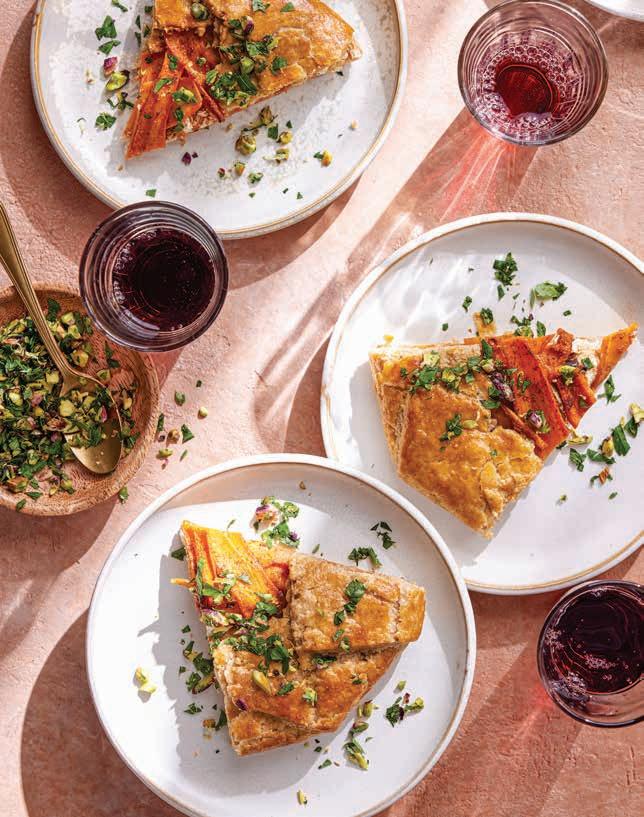
carrots into strips, as thinly as possible. Place in a bowl along with the salt. Let rest for at least 10 minutes. Drain any water, then add the coriander, cumin, ginger, chile, allspice, cinnamon, and cloves, tossing to evenly coat the carrots.
3. Make the whipped feta: Combine the feta, labneh, and lemon zest in a food processor. Blitz until well-combined. Alternatively, you can mash and whip together in a small bowl.
4. Preheat the oven to 425°F. Line a baking sheet with parchment paper.
5. Make the galette: On a lightly floured surface, roll the prepared dough into a 12-inch circle and transfer to the prepared baking sheet. Place an 8-inch plate, upside down, gently on the dough to leave an indentation to guide the inner circle. The goal is to leave at least 2 inches around the edge of the dough. Use a sharp knife to cut slits every 3 to 4 inches along the dough border, then carefully remove the plate.
6. Spread the feta mixture evenly over the center circle. Layer the carrot mixture evenly on top of the whipped feta.
7. In a small bowl, whisk the egg until frothy. Take one of the border sections of dough and fold it over the filling. Brush with the egg, then repeat with the next section of dough, overlapping it slightly with the previous section. Continue in this fashion all the way around the dough border. Bake the galette for 22 to 24 minutes, until the crust is crisp and golden. Let cool for 10 minutes.
8. Make the pistachio sprinkle: Put the parsley, pistachios, lemon zest, and salt in a small pile on the cutting board. Chop back and forth until the mixture is well-combined and the pistachios are crushed.
9. To serve: Cut the galette into six wedges and top with the pistachio sprinkle before serving.
Erin shares her start-up strategy to create a limitless larder.
CATALOGING IS KEY
Erin borrows a trick from professional kitchens and keeps an inventory list on a piece of paper taped to the inside of her cabinet and a digital Excel sheet that can be tapped into from the grocery store. The last thing any of us needs is yet another bag of Rancho Gordo beans left to expire in the back of the abyss.
NUTRITION IN NUMBERS
When it comes to starting your dry goods journey, Erin recommends keeping five or so varieties each of grains, legumes, nuts, and seeds on hand to allow you to make a wide range of plant-based meals. Feeling overstocked and overwhelmed? Pare that down and focus on one pearled grain, such as barley or emmer, a medium-size bean, such as pinto or black beans, and a useful nut, such as peanuts or almonds. This combination still allows for a lot of explorative cooking while still being an easy and satisfying place to start within the book.
It’s no surprise that Erin’s inspiration stems from the food she grows in her own garden. Getting to know your ingredients in a more intimate way will expand your creativity while providing access to fresh spices and legumes, which have a much fuller flavor and texture. Erin’s journey cultivating her own food has expanded from growing heirloom vegetables to harvesting and processing her own wheat, inspiring us to cultivate our own plot-to-pantry lifestyle.
Pantry-forward cooking invites big flavors. In addition to grains, legumes, nuts, and seeds, Erin encourages cooks to experiment with a number of vinegars, oils, spices, dried chiles, and fermented sauces to bring dishes to life. She also suggests using her recipes as guides and to embrace your inner child, allowing yourself to push boundaries while learning what tastes good to you by experimenting on small portions first—even if it means overdoing it on the first try.


Join us on a cozy holiday getaway to Nick’s Cove, where the guests and staff are grateful for this nostalgic slice of classic California that’s weathered storms and a fire, and continues to go strong. This holiday-ready party menu is a celebration of the riches of the coast.
Story by HUGH GARVEY / P hotographs by THOMAS J. STORY
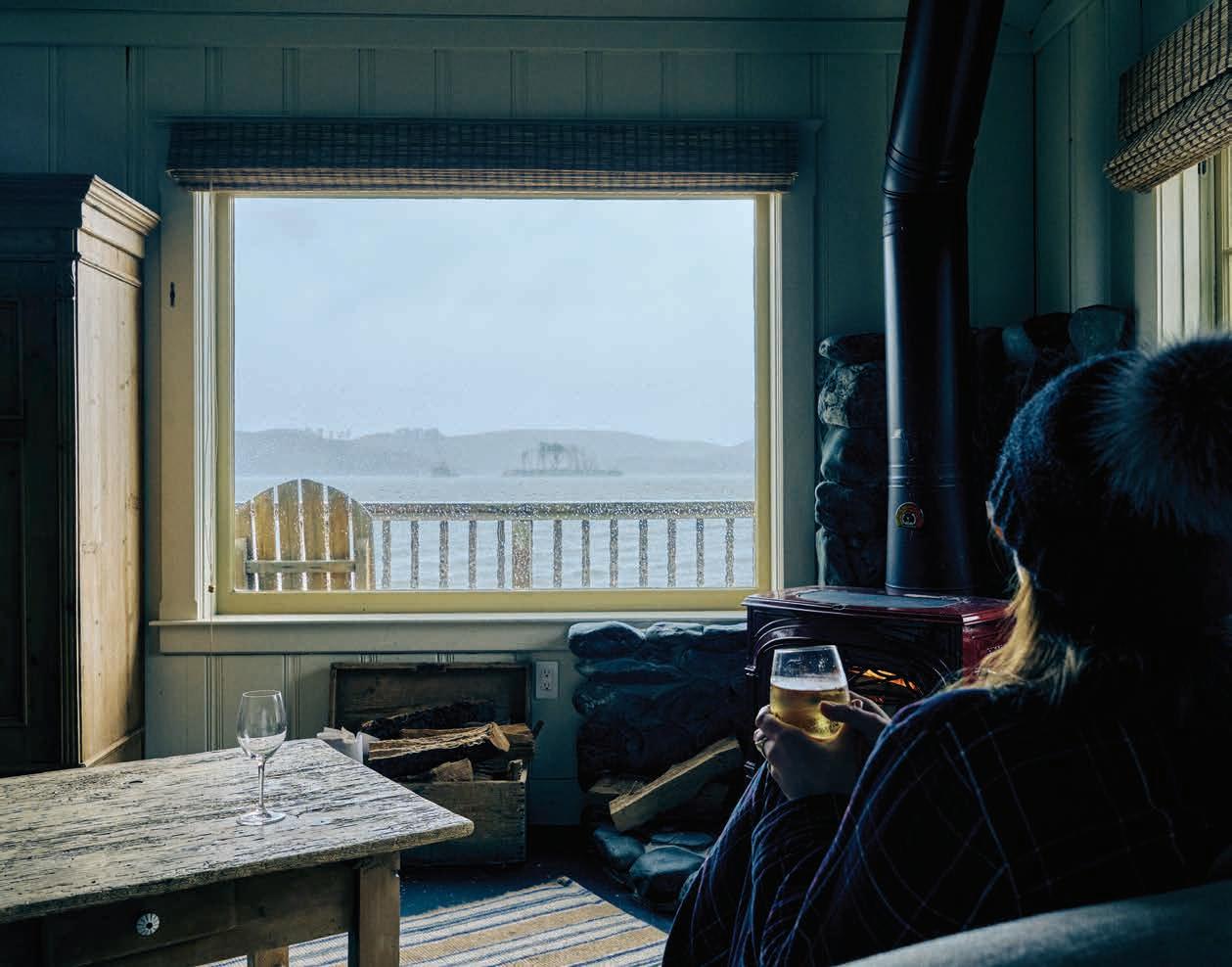
the restaurant and collection of perfectly weathered little cabins that sit on the shore of achingly beautiful Tomales Bay in West Marin. It’s a perfectly preserved little sliver of the California that time forgot: rolling hills and pasture and inlets and an expanse of water on which you might spy kayakers or small fishing boats and waterfowl and not much else. It’s pretty much the same as it was in
1931 when a Croatian immigrant named Nick Kojich opened a little seafood restaurant in an old herring curing facility and started renting out waterfront cottages by the night and serving shrimp and crab cocktail to road trippers.
One of the most charming outbuildings at Nick’s Cove was the boathouse. Full of antique rods and reels, glass buoys, nets, life jackets, an old
piano, a dinghy suspended from the roof, and a wood-burning stove in the corner, it’s where people would bring their trays of oysters and cocktails and eat out over the water. Locals would moor their boats there after making their way across the bay from the docks at Inverness. It was the site of proposals and weddings. It’s also where chef Chris Cosentino of San Francisco restaurants Incanto and Boccalone fame would sit and work on the menu for Nick’s Cove after he was hired as the executive chef to improve the culinary offerings that had evolved, albeit slowly, over the
The creamy combination of black cod, cream cheese, dill, Dijon mustard, and Old Bay is elevated and instantly nostalgic. You can serve it with a crisp celery salad and fried saltines, or if you’re not up for frying, it’s amazing with chips, crackers, or toasted sourdough. Chef Cosentino brines and house-smokes his black cod, but feel free to substitute a high-quality smoked white fish to simplify the recipe.
MAKES 5 CUPS
1 gallon water, divided
½ cup kosher salt
1 tsp. peppercorns
½ cup brown sugar
2 tsp. thyme leaves
4 each fresh bay leaves
1 medium yellow onion, julienned
3.7 lbs. (2 filets) black cod
½ cup finely diced shallots
2 Tbsp. fresh dill
1½ lb. cream cheese
2 Tbsp. Dijon mustard
4 tsp. Old Bay seasoning
2 tsp. lemon juice
3 tsp. kosher salt
2 tsp. black pepper
1. In a large pot, combine the sugar, salt, peppercorns, thyme leaves, bay leaves, and onion to ½ gallon of water. Cook over medium heat, stirring occasionally, until sugar and salt are dissolved. Add the last 2 liters of water.
2. Let cool completely. Add the fish, then brine fish for 2 hours in the refrigerator.
3. Once the fish is brined, drain, pat dry, place on a plate, and let air-dry in the refrigerator for 4 hours.
4. Following your smoker directions, start with a 2-hour cold smoke with a wood of your choosing, then finish with a hot smoke until fully cooked at 245°.
5. Remove and let the fish cool.
6. Roughly chop the smoked fish and place in a bowl mixer with the paddle attachment.
7. Add shallots, dill, cream cheese,
mustard, Old Bay, lemon juice, salt, and pepper, and mix gently until all incorporated.
8. Store in a clean non-reactive container in the refrigerator until ready to serve.
How do you make saltines better? Fry them! It’s a cheffy trick that takes the dip experience over the top.
MAKES 10 SERVINGS
1 box saltines
Neutral oil, such as canola
Sea salt, to taste
Freshly ground black pepper, to taste
1. In a shallow pan, bring oil to 375°.
2. Fry the saltines in batches until golden brown, about 3 minutes.
3. Place on a paper towel and season with salt and pepper while warm. It will stay fresh in an airtight container for one day.
MAKES 3 / 4 CUP
¼ cup lemon Juice
½ cup extra-virgin olive oil
Sea salt, to taste
Freshly ground black pepper, to taste
1. Add all ingredients to bowl & mix with whisk.
2. Season with salt and pepper.
Dressed with a simple lemon vinaigrette and garnished with fresh parsley and celery leaves, this simple salad is a bright counterpoint to the luscious dip.
MAKES 1 CUP
¼ cup celery hearts, shaved
¼ cup thinly sliced shallots, cut into rings
¼ cup flat-leaf parsley leaves
¼ cup celery leaves, yellow only

3 Tbsp. lemon vinaigrette (see recipe at left)
Sea salt, to taste
Freshly ground black pepper, to taste
1. Fill a medium bowl halfway with water. Add 1 Tbsp. salt and stir until dissolved. Add ice. Add shallots and let soak for 10 minutes. This will remove the punch of the shallot. Drain shallots in a colander.
2. Place all the ingredients in a serving bowl and season with salt and pepper.
3. Dress lightly with lemon vinaigrette.
TO SERVE:

3 cups black cod dip (see recipe at left)
1 cup celery salad (see recipe at left)
2 sleeves fried saltines (see recipe at left)
Sea salt, to taste
Freshly ground black pepper, to taste
1. Place the smoked black cod dip in a bowl or on a large platter.
2. Season with sea salt and black pepper.
3. Top with the celery salad and serve with a ton of fried saltines.
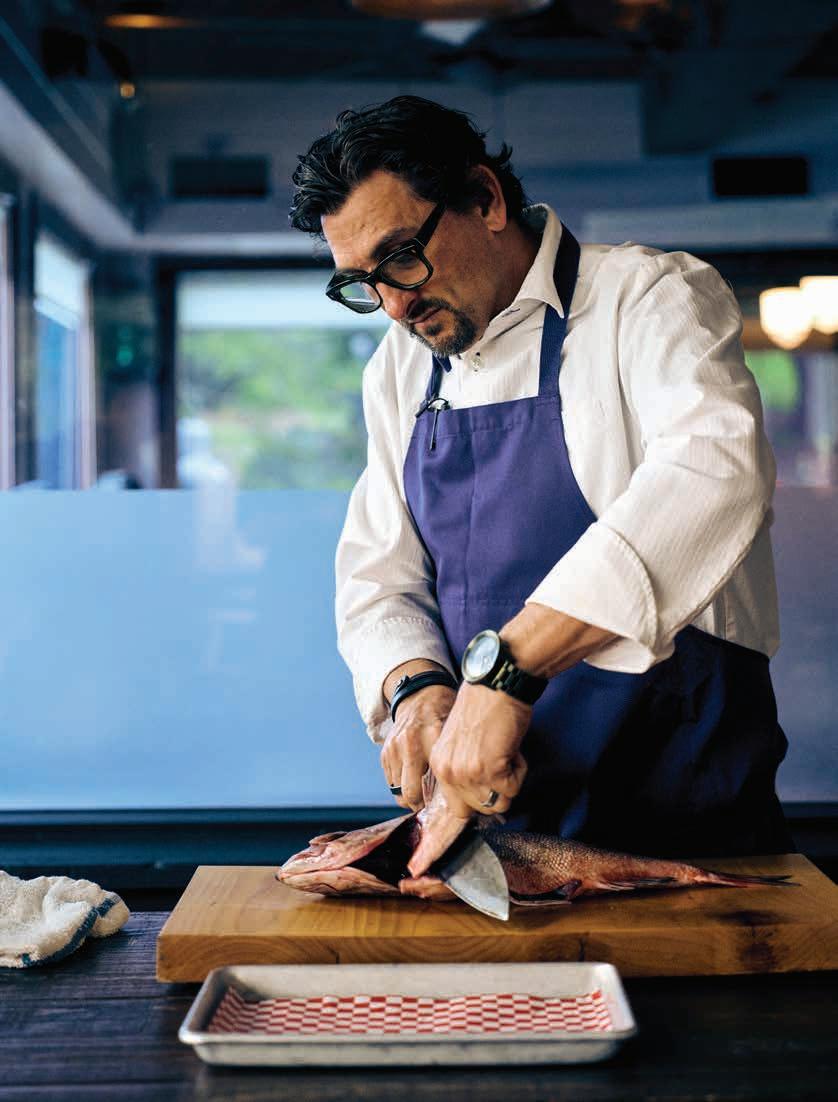
decades since Kojich opened the restaurant. The no-nonsense early years that Nick presided over were followed by a foodie blossoming of sorts in the 1990s, when Bay area restaurateurs Pat Kuleto and Mark Franz bought the place, taking full advantage of the fact that within a hundred miles, you’ve got some of the best food purveyors in the United States: Hog Island Oyster Co., Liberty Ducks, Point Reyes Farmstead Cheese, Cowgirl Creamery, County Line Harvest, and the list goes on.
“This is a very unique environment,” says Cosentino, who just wrapped up his contract and is now working on his next restaurant
project. “We’re on the ocean that has oysters, and then we have all our dairy, beef, and produce farms right on the same hill. It doesn’t exist anywhere else, except for in England where it’s all sheep farms. This is a fish house. A fish house is for everybody.” Cosentino has revived the locavore traditions, committing himself to making the restaurant truly of its time and place but also reflective of his upbringing in Rhode Island. He added dishes like Rhode Island and New England chowders, perfected the fish and chips, and dialed in the fish house culinary vernacular. “That boat shack was what drew me in because walking in there felt like I was in my grandfather’s
Chef Chris Cosentino’s take on the classic Shrimp Louie is the perfect party appetizer and captures the throwback essence of Nick’s Cove. This recipe easily doubles to serve more guests.
SERVES 4
1 head Little Gem lettuce, leaves picked off of stem
1 Persian cucumber, oblique cut
6 green beans, blanched and cut in 3” long
2 Tbsp. oven-roasted Roma tomatoes (in the winter) or fresh tomatoes (in the summer) (see recipe at right)
3 cooked fingerling potatoes, cut into ½-inch cubes (see recipe at right)
½ avocado
¼ tsp. parsley leaves
¼ tsp. tarragon leaves
½ tsp. capers, non-pereil
1 tsp. kosher salt
¼ tsp. black pepper
1 each soft-boiled egg
2 Tbsp. lemon vinaigrette (see recipe previous page)
6 oz. prepared shrimp (see recipe at right)
¼ cup Louie dressing (see recipe at right)
1. Place all the ingredients in a mixing bowl except the egg, shrimp, and dressings.
2. Gently mix all the items, being careful not to bruise.
3. Season with kosher salt and black pepper.
4. Dress the salad bowl with the lemon vinaigrette, then toss evenly.
5. In the serving bowl, place a layer of the Louie dressing on the bottom of the bowl.
6. Lay the seasoned salad in the bowl on top of the Louie dressing.
7. Place the soft-boiled egg on the top, crack open, and season with cracked black pepper and flake salt.
8. Serve with the dressed shrimp on the top of the salad.

SERVES 4
4 Roma tomatoes, cut lengthwise
3 Tbsp. extra-virgin olive oil
Sea salt, to taste
Freshly ground black pepper, to taste
1 tsp. fresh thyme leaves
1. Preheat the oven to 175°, ideally with the convection fan on.
2. Line a sheet pan with parchment paper.
3. Lay Roma tomatoes on the parchment paper, open side up.
4. Season with salt, black pepper, and thyme, and drizzle with extra-virgin olive oil.
5. The goal is to reduce the amount of water in the tomato by slowly dehydrating it so it becomes a superrich flavor bomb. Be mindful and watch them to make sure they don’t burn. They will become nice and soft in about 2 hours.
6. Once cool, remove tomatoes to a non-reactive container and place the extra oil from the parchment on top of the tomatoes to be absorbed.
YIELDS 1 PORTION
6 oz. bay shrimp
2 Tbsp. Louie dressing
½ tsp. kosher salt
¼ tsp. black pepper
¼ tsp. finely chopped chives
1. In a mixing bowl, add the bay shrimp.
2. Dress with salt and pepper, then add the Louie dressing and chives.
3. Place in a small bowl to serve.
MAKES 1 CUP
3 fingerling potatoes
1 baseball card-size piece of kombu seaweed
2 2-inch-long lemon peels
1 Tbsp. sea salt
1. Place the potatoes, salt, lemon peel, kombu, and cold water in a non-reactive pot. Bring to a boil, reduce to a low boil, and cook until potatoes are tender, approximately 15 minutes. Remove potatoes from water and set aside.
2. Use a paring knife to peel the skins while they are warm and set aside.
SERVES 4
1 cup mayonnaise
3 Tbsp. ketchup
4 tsp. finely chopped cornichons
2 Tbsp. lemon juice
¼ tsp. garlic, paste
¾ tsp. Tabasco sauce
¾ tsp. Worcestershire sauce
4 Tbsp. smoked paprika
4 Tbsp. chili powder
½ tsp. kosher salt
4 Tbsp. black pepper

Mix all ingredients in a bowl, making sure to adjust seasoning as needed.





beach house. It looked like that. It felt like that. It was open stud walls. He had the blown-glass lobster pot buoys. The old fishing equipment. That’s what I grew up with, so for me what makes it time and place. We’re using what’s here, plus we’re making my grandmother Helen’s bread and butter pickles—it has to feel like what it is and have an inkling of where I’m from.”

All was well until the evening of Jan. 7. Patrons and staff were in the restaurant and saw smoke coming from the boat shack. Within seconds, the flames engulfed the structure. By the time the fire department arrived on scene, the building was a charred shell. It was a tragic day for all the people who’d dined in or launched their boats from what was the most picturesque little outcropping of this magical establishment, and the Nick’s Cove Instagram was flooded with condolences and teary posts from families and couples who’d celebrated milestones at the end of that pier. Fortunately, nobody was hurt during the fire, the pier survived, and within months, enough money was raised through private donations to cover the cost of its reconstruction. The plan is to restore it to its former charming glory, complete with glass buoys, vintage fishing equipment, and a piano.
Shortly after the fire, we visited Nick’s Cove, and all but for the charred boathouse at the far end of the pier, which was cordoned off, the restaurant and cottages were in full cozy effect: Fishermen bobbed out on the bay, road trippers pulled in for fish and chips, and guests tucked into towers of seafood and cured meats and looked out at that unspoiled view.
The place is all you’d want of a California fish house and more, with thoughtful flourishes and intentional techniques that make the difference between delicious and exceptional food. And that just happens to be the kind of thing you want to serve around the holidays. Cosentino’s smoked black cod dip is rich and herby and nuanced. When served with fried saltines, it’s an over-the-top and indulgent appetizer. The oysters are taken to the next level by a garlicky butter and homemade barbecue sauce. The Shrimp Louie is a sweet take on the classic. And the cocktails are crafted to evoke the warming wintery vibes of hunkering down in a cozy cottage by the bay.
A dialed-in version of a coastal classic. If you’ve never made your own barbecue sauce before, this is your chance to taste the profound difference between corn syrup supermarket stuff and the real deal, made with good spices and exacting technique.
SERVES 6 AS AN APPETIZER
2 ½ cups rice wine vinegar
2 ½ cups cider vinegar
¼ tsp. ground cloves
1 ½ tsp. ground allspice
4 Tbsp. ground coriander
2 medium yellow onions, julienned
3 or 4 each garlic cloves, confit
1/3 cup olive oil
1 ¼ cups Heinz ketchup
½ cup molasses
2 ¾ cups brown sugar
Red Boat Fish Sauce, to taste
1 ½ Tbsp. Worcestershire sauce
1. In a non-reactive pot, add the vinegar and the toasted ground spices and reduce by half.
2. In a non-reactive large rondeau pan, add oil and caramelize the julienned onions over medium-high heat for 30 minutes, then add the confit garlic when the onions are golden.
3. Add molasses and brown sugar to the caramelized onion mix, then simmer together for 5 minutes, stirring to prevent burning.
4. Strain the vinegar and spice reduction, then add the strained vinegar mixture to the onions and molasses. Mix and bring to a boil.
5. Add the ketchup and Worcestershire and simmer over medium-low heat for 1 hour.
6. Blend well with a stick wand, then adjust with the Red Boat Fish Sauce.
7. Cool and store in the refrigerator.
½ lb. unsalted butter, room temperature
3 Tbsp. garlic, chopped
2 Tbsp. flat-leaf parsley, leaf and stem, chopped
1 ½ tsp. Red Boat Fish Sauce
1. Place the room temperature butter in a mixer with the paddle, then add the parsley and garlic.
2. Paddle to incorporate the garlic and parsley, add the fish sauce, and mix well.
3. Roll into thin logs in parchment paper. Keep in the refrigerator until ready to use.
TO SERVE:
12 oysters, shucked
8 tsp. barbecue sauce (see recipe at left)
2 Tbsp. garlic butter (see recipe at left)
1. Using a squirt bottle, place the barbecue sauce into the cup of the oyster.
2. Warm the garlic butter, then spoon it onto the oyster into the cup with the barbecue sauce.
3. Place oysters directly on the grill and let them cook for about 5 minutes.
4. You will see them bubbling; this is the time to remove them.
5. Once the oysters are cooked, serve on a bed of warm rock salt with an oyster fork.
The naturally sweet squash is seared and roasted to perfection, then finished with a rich brown butter infused with sage and the tang of malt vinegar.
SERVES 2
1 medium delicata squash
6 Tbsp. butter
10 sage leaves
4 Tbsp. malt vinegar
Kosher salt, to taste
Freshly ground black pepper, to taste
1. Cut the squash into 1-inch-thick rings, then remove the seeds with a small spoon.
2. In a sauté pan, sear the squash on both sides, making sure to get even color and cook ¾ of the way, about 5 minutes per side.
3. Once the squash has nice color on both sides and has been cooked ¾ of the way through, add butter and place in a 500° oven for 5 minutes.
4. Return to the burner and add the sage leaves and deglaze with the malt vinegar.
5. Place on the small plate, top with the brown butter sauce, and serve.
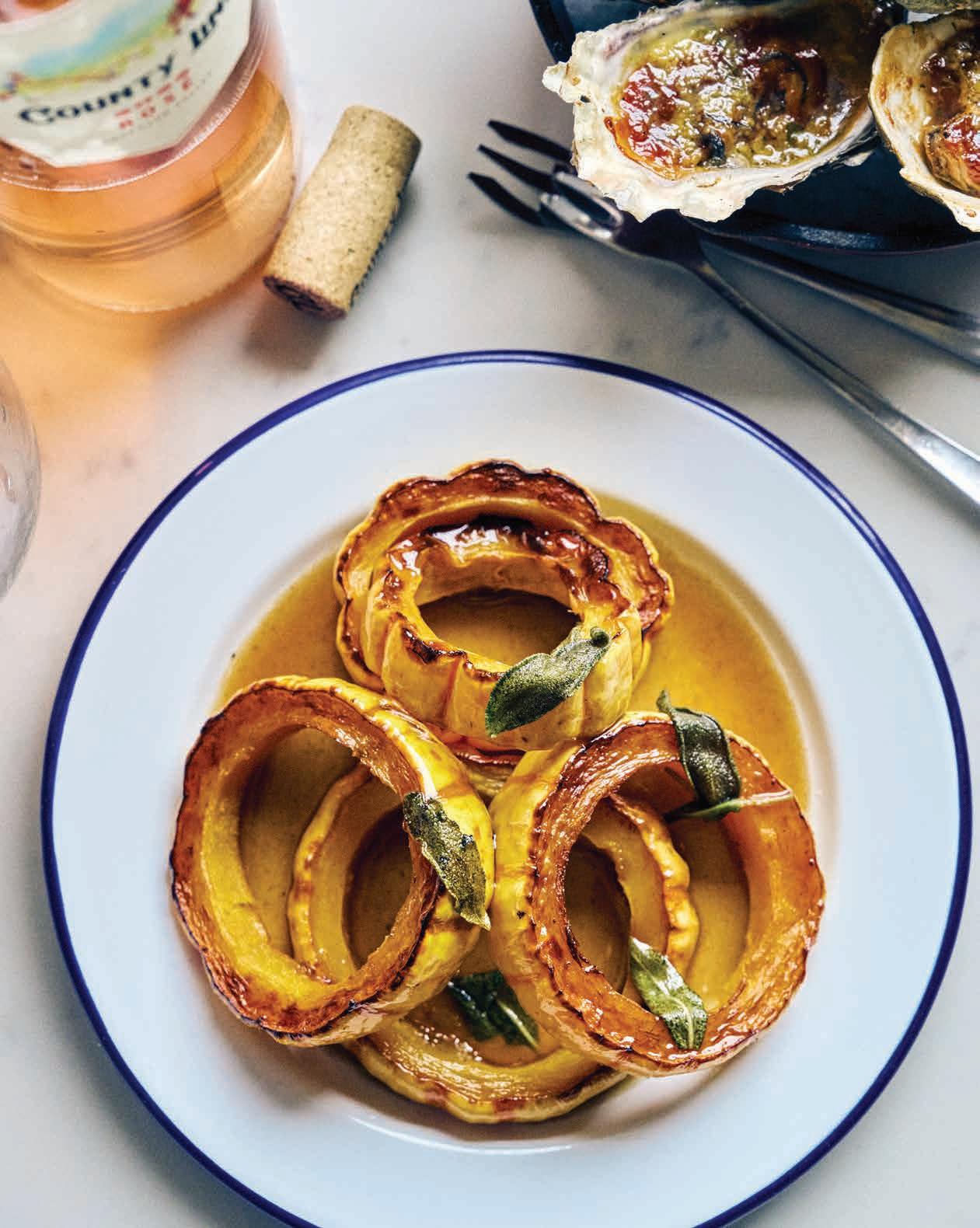
If you aren’t normally a fan of Gin & Tonics, please try this one, and we promise you will be converted! By making your own tonic syrup, you will impress your friends and never be able to go back to those old Gin & Tonics that your grandpa loves. Cinchona bark is the natural source of quinine, and you can buy it and then grind it yourself, or simply buy the powder. We suggest purchasing it from Penn Herb Co., which is a great economical source.
MAKES 2 COCKTAILS
TO MAKE THE TONIC SYRUP:
2 cups water
2 oz. cinchona powder
1 ½ oz. citric acid
Zest of 2 limes
Zest of 1 lemon
4 allspice berries
1 cardamom pod
1 ½ cups agave syrup
FOR THE COCKTAILS:
4 oz. Uncle Val’s Botanical Gin Juice of 4 limes
12 oz. ice
3 oz. soda water
½ lime, cut in wedges
1. To make the tonic syrup, combine all ingredients in a small saucepan and bring to a boil over medium heat. Turn down to low heat and let simmer for 15 to 20 minutes, until reduced by half. Allow mixture to cool and strain through a chinois. You may refrigerate for up to 5 days before using.
2. To make the cocktails, take two rocks glasses and pour two oz. of gin into each. Fill with ice cubes (about 6 oz. of ice) and add 1 ½ oz. house tonic syrup and 1 ½ oz. soda water to each glass. Stir and garnish with a lime wedge.

“This is a fish house. A fish house is for everybody.”

If you like a Paloma, you’ll love this grapefruit and tequila cocktail that pushes the citrus flavor with a housemade cordial and brings the heat with serrano syrup.
MAKES 1
1 ½ oz. Herradura Blanco
1 oz. grapefruit cordial (see recipe below)
¾ oz. key lime juice
½ oz. Mommenpop Ruby Grapefruit Aperitif
¼ oz. serrano syrup (see recipe below)
Top with soda water
Black salt (for rim of glass)
Dehydrated lime wheel (for garnish)
Shake all ingredients (except soda water) and strain into a black salt-rimmed Collins glass over ice. Top with soda water. Garnish with dehydrated lime.
8 serrano peppers, chopped 2 ½ cups water
3 cups sugar
Add peppers and water to a saucepan and heat until mixture reaches a boil. Turn heat down to low, add the sugar, and let simmer for 10 minutes. Allow the mixture to cool and strain through a sieve. You may refrigerate for up to 5 days.
8 grapefruits, juiced (about 40 oz.)
30 oz. sugar
1 oz. citric acid
Juice and strain 8 grapefruits. Combine all ingredients in a medium saucepan and bring to a boil over medium heat. Turn down to low heat and let simmer for 15 to 20 minutes, until reduced by half. Allow mixture to cool, then strain through a chinois or fine mesh strainer. You may refrigerate for up to 5 days before using.
The Marshall Manhattan is based on a classic Manhattan but easier to drink and warming with winter spices. The sweet vermouth is replaced with the much more flavorful stout reduction.
Anderson Valley Oatmeal Stout has toasty and warm notes that are perfect for a foggy night at Nick’s Cove.
MAKES 2 COCKTAILS
FOR THE SPICED STOUT SYRUP:
12 oz. Anderson Valley
Oatmeal Stout
½ cup granulated sugar
2 whole cloves
1 cinnamon stick
¼ tsp. allspice powder
½ lemon, juiced and zest reserved
FOR THE MANHATTAN:
4 oz. St. George Breaking and Entering Bourbon
1 ½ oz. spiced stout syrup
2 dashes Angostura Bitters
Ice
Spiced or brandied Cherries
1. To make the spiced stout syrup, combine all ingredients in a stainless steel saucepan and bring to a simmer over medium heat. Simmer for 20 minutes, until reduced by half. Allow to cool and then strain. You may keep refrigerated, covered, for 2 months.
2. To make the Manhattan, combine all ingredients except cherries in a shaker filled with ice cubes. Stir, then strain into two martini glasses. Garnish each with 2 cherries on a toothpick.

Discover
where Mediterranean grandeur meets a laid-back Santa Monica beach vibe.
Take a culinary journey from the Spanish Balearic Islands to the Amalfi Coast at Terrazza Restaurant and seasonal bistro, Patio del Mar.
Savor artisanal cocktails and nightly entertainment in our Lobby Lounge or relax in our soothing Sea Wellness Spa.

estled in a spectacular sliver of the Salmon River Mountains, McCall, Idaho, is a mountain town somewhat frozen in time. Situated among dense Ponderosa pines, it’s a scenic twohour drive from bustling Boise, but it couldn’t seem farther away. With Brundage and Tamarack Mountains nearby, the main draw for travelers in the winter months is the snow. But even if you’re not a die-hard winter sports enthusiast, there’s a hearty helping of Western nostalgia beckoning in this charming part of the Gem State.
In a world where lift lines at mega-resorts are choked with crowds, the quaint, independently owned Brundage Mountain Resort feels like a step back in time in the best way. First opened in 1961 in partnership with Norwegian Olympic ski champion Corey Engen, the mountain is now phasing in a 10-year plan that will feature a new 20,000-square-foot modern lodge, new lifts, and improved terrain, as well as establishing the first lodging on Brundage. Though as of 2020, it’s no longer owned by the DeBoer Family, descendants of the resort’s co-founder Warren Brown, the homegrown feel remains.
As with many mountain towns in the West, there’s a distinct connection to Nordic alpine culture in McCall. That heritage is being woven into spaces like the Scandia Inn, which was first established in the 1970s by Finnish homesteaders. The boutique roadside hotel has been tastefully revived to reflect the recent fascination with Scandinavian design; think shiplap headboards fashioned from local timber, minimalist Edison light fixtures, and an outdoor barrel sauna. The alpine lodge is a brisk 10-minute walk to the shores of peaceful Payette Lake, which bustles with fishermen and boaters in the summertime. But even when the lake is frozen over, it makes for great views.
In the winter months, life in McCall is all about the snow. Which is what brought me out, too. I tagged along with the 10 Barrel Brewing ski and snowboarding team, who had set up shop at a lodge to film in the mountain’s 18,000 acres of backcountry terrain for the season. While the pros took the Snowcat to catch fresh powder during the day, I headed to Ponderosa State Park Visitor Center to check out McCall’s excellently groomed Nordic ski tracks. The park is peaceful and teeming with wildlife. It’s quiet, meditative, and still—a foil to the shredding the team did up on the mountain.
There’s no shortage of cozy spots for après-ski, but Rupert’s Restaurant at the historic Hotel McCall has one of the best views of the lake in town. It’s known for its extensive wine list and menu stacked with traditional mountain fare like elk meatloaf, and the bar is a great place for people-watching. The hotel has been open since 1904 and serves as a hub for locals.



After a night’s rest, I grab a latte at North Fork Coffee Roasters and head out to one of the area’s magnificent hot springs. Idaho is one of the most thermally active areas of the U.S. The spectacular Burgdorf Hot Springs, located 32 miles outside McCall, requires reservations, as guests need to be snowmobiled in during the winter months. But at Gold Fork Hot Springs, all you’ll need is a solid fourwheel drive to soak your weary bones after a day on the mountain. (Pro tip: Arrive early to avoid the crowds and bring money, as admission is cash-only.)
Back in town, the ideal place to pop in for lunch is Frenchie’s on Third, known for its Creole cuisine like po’boys and delightfully spicy gumbo, as well as a rotating tap of local craft brews, like from Salmon River Brewery based in McCall. There are slightly more gussied-up options in town too, like The Sushi Bar, or The Narrows Steakhouse at the Shore Lodge. But I decided to round out my weekend with a proper feed at the family-owned Brunchette on the Lake, known for its Insta-worthy breakfasts like crème brûlée oatmeal and the Mountain Man special, a stick-to-your-ribs helping of Idaho home fries mixed with caramelized sweet onions, bacon jam, and diced chicken-fried steak, topped with rich country gravy and three farm eggs. Needless to say, I returned home with a full belly after an adventure-filled winter weekender.

“It’s a scenic two-hour drive from bustling Boise, but it couldn’t seem farther away.”

A wintertime road trip reveals wide, open spaces, fewer crowds, and idyllic landscapes in the agricultural heartland of the Canadian Rockies.
Story by KRISTA SIMMONS
by


On par with the azure domes of Santorini or the striped umbrellas that adorn the Amalfi Coast,
the immediately recognizable turquoise alpine lakes of Alberta are undoubtedly Instagram-famous. While springtime in the Western province is indeed gorgeous, rare praises are sung of the winter months, when the region really unfolds, feeling somehow like a secret. The throngs of tourists are nowhere to be found, and traversing the frozen glacial lakes in Banff National Park on Nordic skis as snow gently falls feels like living in a snow globe. It’s quiet, peaceful even—the ideal time to take a road trip through the quaint mountain towns in the Canadian Rockies. Alberta’s world-class alpine skiing at mountain resorts like Lake Louise, Mount Norquay, and Banff Sunshine hardly needs an introduction. But there’s also excellent snowshoeing, cross country, and ice hiking to
be explored. Even if you’re not much of an outdoor enthusiast, there’s plenty to explore in this unique corner of Canada.
In the spirit of going off the beaten path, we started our all-out Alberta road trip in Edmonton, a less expected jumping-off point than Calgary, known worldwide for its annual rodeo festival, the Calgary Stampede. Edmonton is a hub for music, the arts, and great food, and being Canada’s most northerly major city, there’s a whopping 18 hours of daylight in the summertime, meaning the hours to explore are nearly endless.
Edmontonians pride themselves on being punk rock compared to their Canadian counterparts, and it tracks when




considering the countless indie craft breweries, vintage stores, hyperlocal eateries, and speakeasies on offer. That’s not to say it’s rough around the edges, though, especially when it comes to accommodations. The chateau-style Fairmont Hotel Macdonald, originally opened in 1915, offers unparalleled views of North America’s largest expanse of urban parkland and luxe rooms to boot. It’s a perfect spot to rest your head after a night out at Woodwork, a restaurant focused on wood-fired cooking and barrelaged spirits, or a tour of the late-night Neon Sign Museum, an outdoor collection that’s open 24/7 and doesn’t require admission.
The area surrounding Edmonton is considered to be the agricultural heart of the country, and there’s a movement to uplift prairie cuisine taking hold in the city. It’s on full display at RGE RD, named after the range roads that mark the sprawling ranchlands outside city limits. Here, chef Blair Lebsack and wife Caitlin Fulton have evolved their long table field dinners into a full-service fine dining restaurant showcasing all that Western Canada has to offer. Their showstopping nose-to-tail butcher shop, located next door to the restaurant, offers primal cuts from family-owned regenerative farming operations, as well as grab-and-go items like sausage rolls, charcuterie, and sandwiches. We also score some housemade bison jerky for snacking on during a drive across the prairieland en route to our next stop, Métis Crossing.
About an hour and a half northeast of Edmonton is Métis Crossing, a hub for guided cultural interpretive experiences that share the distinct Indigenous story of the Métis—a post-contact tribe that resulted from European fur traders and local Indigenous peoples blending to form their own language, culture, and traditions. Sitting on 512 acres of land near Smoky Lake, the property comprises river lot titles from the original Métis settlers to the region in the late 1800s. Today, the Crossing is home to a tribally owned and operated lodge that includes sky-viewing domes, a cultural center, hiking trails, and a buffalo ranch.
After we drop our bags off in our geodesic domes, we head out to the paddocks with Shirley Pallister, a cultural experience provider at Métis Crossing, to scope out the herd, which includes the magnificent white buffalo roaming the expanse of land.
“Buffalo don’t belong squished in tight quarters, and neither do we,” says Pallister, causing me to pause and reflect on life back home and how this place satisfies a deep craving for wide, open spaces.
After enjoying a sunset walk on the expansive grounds, we spend the evening talking story with Pallister. Though the passing blizzard meant that we didn’t have the typically stunning view of the night
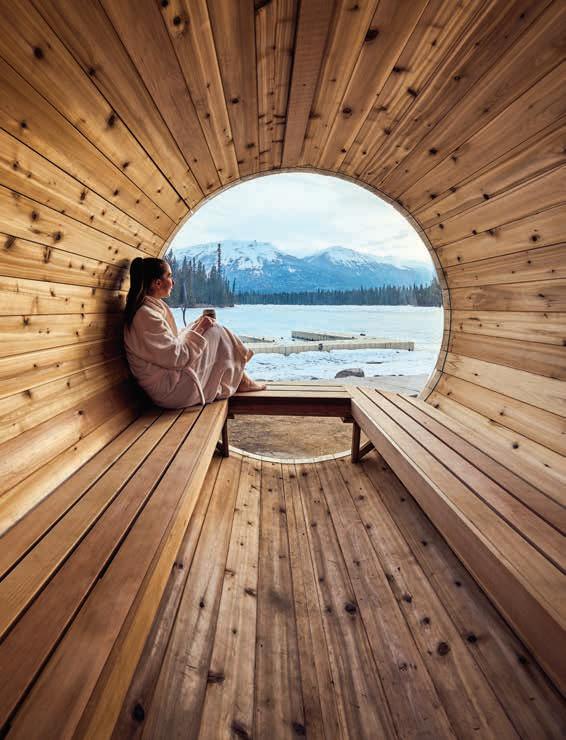



“Buffalo don’t belong squished in tight quarters, and neither do we.”
sky (it’s a prime destination for Northern Lights viewing in the spring), we were able to learn Métis origin stories of the stars and constellations—a guiding light from ancestors that has served as a method of timekeeping, navigation, and understanding when to plant, hunt, and work the land.
After a breakfast of traditional bannock bread, bison, and Saskatoon berry pemmican, we set out to Jasper National Park. Fresh snow dusts the Rockies, and the towering mountains provide a perfect foil to the open road. We pull off at vistas without seeing another car for what seems like hours, enjoying the place to ourselves.
There’s no line to enter the National Park, and we breeze right in to convene at Sixth Bridge at Snake Indian River to meet Cree Knowledge Keeper Matricia Brown of Warrior Women, a company she owns with her daughter Mackenzie. The two have formed a collective that offers a variety of experiences for travelers to engage with, from fireside chats to beading classes to today’s activity—a plant medicine walk.
To many, the winter is a time of dormancy, but as we stroll along the riverbed, life slowly reveals itself through Brown’s keen ancestral knowledge, which allows her to see the flowers, trees, shrubs, and plants as food and medicine. Even now, there’s plenty to harvest, like fir and spruce sap, bearberries, juniper berries, birch bark, and old man’s beard lichen that can be used for making healing salves, tisane, and mineral salts. (It’s worth noting that because of Treaty 8, Brown can harvest plants within the National Park; guests cannot legally forage without a tribal guide.)
We crush up some of the juniper berries in our hands and inhale the aroma. It’s fresh, crisp, and enlivening. She explains that they’re full of vitamin C and were once used to treat scurvy. Aside from making gin, they also have unique culinary uses, too.
“I actually warm them up and put them with a bit of maple syrup and use it as a glaze on my salmon,” says Brown.
Birch bark has anti-inflammatory properties. Bearberries (also known as kinnikinnick) have been used to treat kidney issues. Willow tea, naturally loaded with salicylic acid, is a pain reliever similar to aspirin. As we harvest, we’re reminded of how much of what we know as modern medicine is actually mimicking the healing properties of nature.
“We don’t honor the spirit when we make
On previous page: Matricia Brown with a traditional drum at Lac Beauvert in Jasper National Park.
Right: buffalo grazing at Métis Crossing; deer hiding in the shrub at Métis Crossing; Brown holds pine cones and other traditional medicines on the plant walk in Jasper National Park.




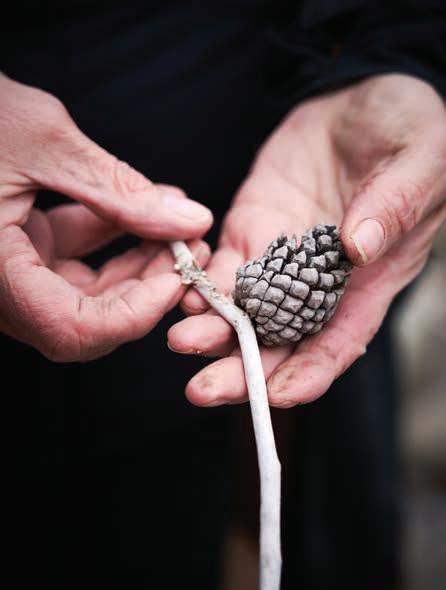

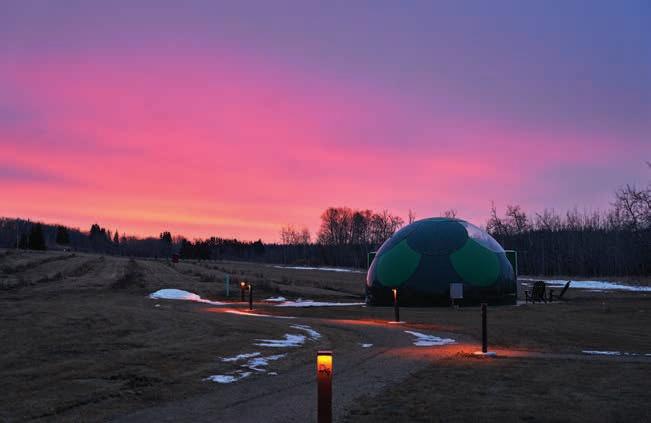
medicine like aspirin. It doesn’t have spirit with it. But when you drink willow tea that you’ve harvested, sure, there’s salicylic acid in it. But you have to consider other parts of the structure of that tree that make it whole, otherwise, we’re taking the spirit out of it,” she says. “We can’t just assume that that one single part is the most important part of the willow.”
After preparing healing Epsom salts with our gathered goodies, we head on to Fairmont Jasper Park Lodge, a luxe mountain resort situated right on the UNESCO World Heritage Site. Brown works closely with the hotel on its cultural programming, which includes an opportunity for guests to gather tisane ingredients to enjoy while relaxing in the property’s brand-new barrel sauna overlooking Lac Beauvert.
In a not-so-wellness-oriented move, I order a cozy Canadian meal of poutine and an old fashioned at the hotel’s restaurant, The Great Hall, to top off the night. And yes, it was worth it.
The final leg of our road trip is the drive from Jasper to Banff along what’s undoubtedly one of the world’s most scenic byways, Icefields Parkway. And it turns out, ending the trip with a bang in Banff and Lake Louise is absolutely a pro move. After days in quiet mountain towns, the bustle is welcomed. Checking into Moose Hotel, whose amenities include two spectacular rooftop hot pools with views of the Canadian Rocky Mountains, we quickly drop our bags in search of some action. (You can take the girl out of L.A.…)
The blizzard socking in our views of Lake Louise ended up being the perfect excuse to call it a day and grab beers at Three Bears Brewery before doing some serious damage shopping for vintage finds at The Last Temptation. Then, we headed to dinner at Hello Sunshine, a retro-inspired Japanese joint known for its groovy dining room and excellent sushi. All of it was great, but the star of the show was, no surprise, the locally sourced beef tataki, a clever twist on the dish made with garlic ponzu, manchego cheese, and garlic chips. Looking around at the ultra-hip après crowd, it became clear that Alberta has officially arrived.
At press time several businesses in this story were closed due to wildfires but are anticipated to open by mid-October. Be sure to contact them before booking.

David DeFazio’s adventurous spirit has led him to experience everything his Wyoming backyard has to offer, from fly-fishing to backcountry skiing to guiding whitewater rafting expeditions to eventually becoming the co-founder of Wyoming Whiskey. Originally an attorney, DeFazio now works with co-founders Brad and Kate Mead to craft exceptional bourbon made with locally grown, non-GMO corn, winter wheat, barley, and winter rye. Here, he shares his favorite local establishments that share a passion for Western craftsmanship.
This month: Jackson, WY
The insider: David DeFazio, Founder of Wyoming Whiskey

First opened in 1941, The Wort Hotel is the historic hotel in Jackson. It manifests its rich past through newly appointed Westernthemed rooms and accommodations. Few hotels bring that authentic character to life while still maintaining a level of luxury that travelers desire, but the Wort accomplishes this effortlessly. Don’t miss live music on Tuesday nights, where you can swing dance with the best of ‘em. The Cloudveil is centrally located on the Town Square in Jackson and provides a modern, rustic elegance. It also helps that it has an excellent Parisian brasseriestyle restaurant in-house called The Bistro and a comfortable lounge to enjoy live music and cocktails while feeling the vibe of the town.
Seasonal diversions and secret travel tips from local experts.

Glorietta Trattoria offers outstanding Italian fare and top-flight cocktails, and it’s just a short walk from the Town Square. A seat at the bar usually results in healthy conversation with the bartenders and other bar-favoring diners. Located on Glenwood Street just a block from the Town Square, The Kitchen offers New American cuisine with a raw bar serving up a healthy offering of sushi. This is a spot where you can often walk in and get either a seat at the bar or a table without reservations. My recommendation: the bison tartare.
There’s nothing more Western than a shot of Wyoming Whiskey and a Coors Banquet at Million Dollar Cowboy
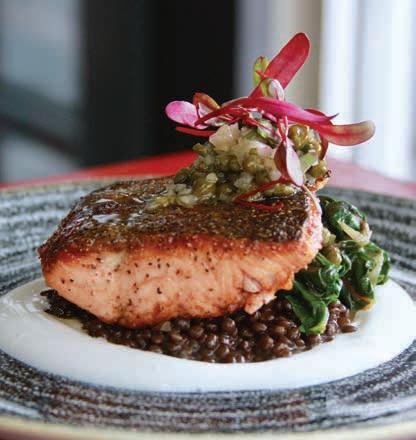
Bar, enjoyed while sitting on a saddle at the bar. Live music, dancing, pool tables, and historic murals all add to the experience. If you’re looking for a great cocktail and an unmatched view, take the Bridger Gondola up to Piste Mountain Bistro at
the Jackson Hole Mountain Resort in Teton Village. You’ll be 2,500 feet above the valley floor with unobstructed views of the Snake River and mountain ranges to the south and east. Drink in the views. All of the cocktail selections are delicious.
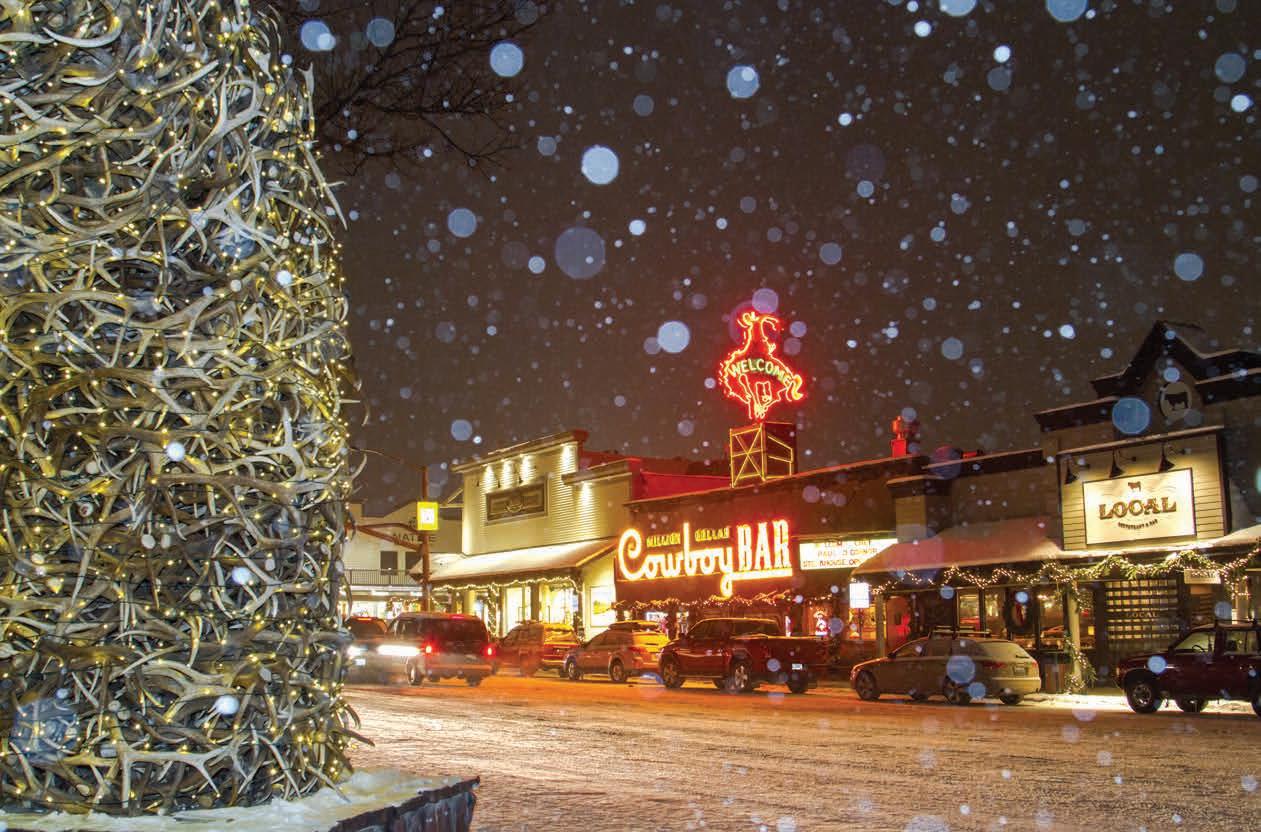


Ayla Kapahi is the head of the femaleowned and operated Borderlands Brewing Company, whose two Tucson locations are known for award-winning, innovative beers (Horchata cream ale, anyone?). Kapahi is passionate about creating cross-cultural collaborations that empower women, like the brewery’s Las Hermanas, which linked about 40 Hispanic brewers on both sides of the border to create a delicious, Southwestern-inspired lager. Kapahi also co-founded Pink Boots of Southern Arizona, a nonprofit supporting women in alcohol fermentation sciences. Here, she highlights spots with serious Sonoran flair in her hometown of Tucson.
National Park with the most beautiful desert views. I love being able to hike right from the property and then spend the afternoon on the lazy river.
This month: Tucson, AZ
The insider:
Ayla Kapahi, Director of Production, Borderlands Brewing Company

Hotel McCoy is an affordable, 1960s retro hotel that captures the spirit of Tucson. It has a great location with a fun craft beer and wine bar. And JW Marriott Tucson Starr Pass Resort & Spa is right in the heart of Saguaro

Contigo Latin Kitchen is known for its delicious tapas and paella. It features one of the best views of Tucson, especially for sunsets! Rollies
Mexican Patio serves up authentic Mexican street food. Try the potato rollies, or rolled tacos, and anything made with the signature beef birria. Order the tamale-stuffed lobster at Charro Steak & Del Rey. It’s one of my favorite Tucson dishes. And go for the birria pizza at Zio Peppe, and save room for the chocolate taco cannolis!
Aside from Borderlands Brewing Company, a wise pop-in is REVEL Tucson Wine Bar. It has an excellent list of rotating wines and offers delicious charcuterie boards with local meats and cheeses. The staff are so knowledgeable, and friendly, too. Presta Coffee Roasters


offers small-batch beans, roasted with care and expertise. And Good Oak Bar shakes up delicious and creative cocktails
with a Southwestern twist.
Arizona-Sonora Desert Museum is an outdoor
wildlife preserve in Saguaro National Park that features interactive experiences, including the Raptor Free Flight and Stingray Touch. It’s truly an immersive desert experience. Catch a comedy show or performance at Hotel Congress , a classic and intimate Tucson venue. Check out local art and handmade goods from Pop Cycle And take a stroll through Old Town Artisans , where you’ll find shops like La Cocina Cantina, featuring a variety of vintage and traditional Southwestern items.







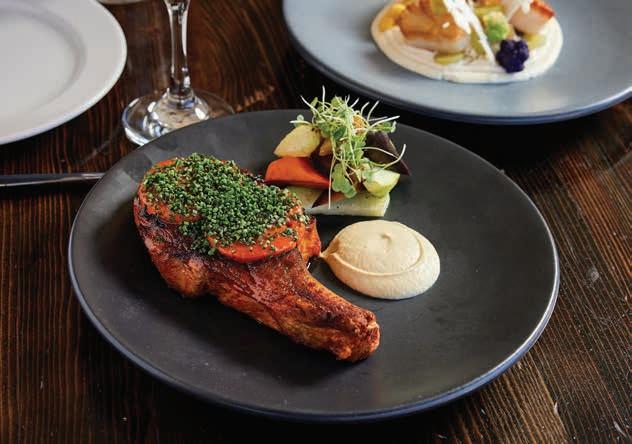
Lauren Bates is the founder of Wild Terrains, a travel company that collaborates with women hoteliers, chefs, artists, and designers for global itineraries that include trips throughout the Western United States and Mexico. Because the busy entrepreneur spends so much time on the move, she relishes quiet moments spent outdoors in her home of Boulder, preferably on a trail or paddleboard with her two dogs, Milo and Ollie. Here, she shares some of her favorite women-led brands in this charming Colorado town.
Boulder has a pretty impressive lineup of restaurants for a city its size. One of our favorites is Oak at Fourteenth I literally dream of its apple and kale salad with candied almonds, grana padano, and togarashi. In the summer, I enjoy venturing outside the city for magical dinners under the stars. Mirasol Gomez and Nicole Carrillo of the Forage Sisters host a summer dinner series that allows you to visit some
annual Chinese New Year dinner party, a nod to her heritage. After a morning hike, my favorite stop is Wonder Press, a womenowned cold-pressed juice shop with delightfully healthy juices, smoothies, and elixirs.
This month: Boulder, CO
The insider: Lauren Bates, Founder of Wild Terrains

pretty epic locations in Colorado, all while supporting local farmers.
I love popping into Jess Liu’s Creature Comforts Cafe for an afternoon pick-me-up or a glass of wine at happy hour. In the evenings, she uses her space to host fun cultural events that support the local community, like the
Boulder is all about being outside and soaking in all the nature. Chautauqua Park is the most iconic viewpoint in Boulder at the base of the Flatirons, and it’s a favorite place to hike for locals and visitors alike. In the summers, we also love driving 40 minutes north to Brainard Lake Recreation Area with our paddleboard and dogs. My husband and I got married here this summer because the location is so special. Most of the locals are fitness enthusiasts, so there are also tons of great workout studios and classes to take. I’m addicted to Tate Cohen’s Lagroove Pilates classes. Somewhat of a local secret is the Eldora Women’s Program Located about 21 miles west of Boulder, it offers an incredible ski clinic, which is taught by all women ski instructors. I took my first lessons last year, and it was such an amazing experience.
What began as a pop-up exhibition for female-identifying artists to show their work in 2019 has grown into The New Local a nonprofit art gallery and shop. It’s a gorgeously curated place to pick up a gift. I also really enjoy visiting Rebecca’s Herbal Apothecary & Supply, a beautiful shop that stocks herbs and teas in bulk and is a lovely place to learn about herbal medicine and remedies.
Give the gift of the Sunset Wine Club, featuring the best bottles in the West, perfectly paired with recipes in the magazine.
There’s no more perfect holiday present than the Sunset Wine Club, a selection of story-worthy wines produced by the top vintners in California, Oregon, Washington, and beyond—delivered straight to your door. We’ve partnered with the country’s premier online wine retailer, Wine Access, to curate a standout mix of reds, whites,
bubblies, and rosés to drink this season. Think of each delivery as a box of aperitifs, party-ready bottles, and weeknight dinner solutions. Even better, they’ve been selected to go with the recipes and menus in the issue you’re holding in your hands. As a member of the Sunset Wine Club, you will receive the following exclusive benefits:

WINES INOURNEXT SHIPMENT!

2021 Omen Red Blend Sierra Foothills
PAIRS WITH: Lentil Croquettes with Za’atar and Labneh (page 55). The herbal notes of the dish are amplified by the woody, cedar accents in the wine. The juicy acidity of the red blend cuts the richness of the croquettes perfectly.

2018 Five Star Cellars Cabernet Sauvignon Walla Walla Valley
PAIRS WITH: Ras El Hanout Carrot Galette (page 57). Both the dish and the wine celebrate the interplay of savory and sweet. Ripe berry flavors in the wine and the natural sweetness of carrots match up, while the earthy, nutty flavors of the dish are reflected in the oak accents of the wine.
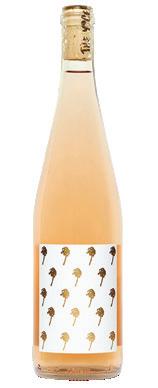
2023 The Vice Orange Wine of Albarino California
PAIRS WITH: SesameGochujang Cauliflower Lettuce Wraps (page 54). A fun pairing with an adventurous dish. The skin-contact wine bursts with flavors ranging from fruity to earthy with a kick of acidity and bitterness. A dish to match must also come with punches of flavors. The spicy, sweet, nutty sauce delivers just that.
Each bottle is thoughtfully crafted by a group of diverse, environmentally responsible winemakers.
Sunset Recipes, Profound Pairings
Every bottle comes with exclusive tasting notes and suggested pairings for Sunset recipes, hand-picked by sommeliers.
Subscribe to the Sunset Wine Club and you’re not just getting wine shipments. You’re getting a taste of the magazine’s featured selections and the captivating story behind each bottle. It’s an invitation to sit and sip at the Sunset table. $120 per shipment.
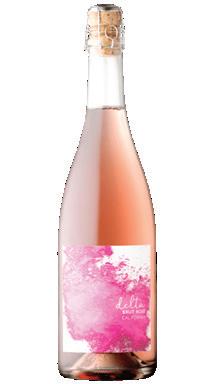
2023 Delta Brut Rose California
PAIRS WITH: Nick’s Cove Shrimp Louie (page 62). Letting the sweet, briny shrimp shine is the ultimate goal of this pairing. A delicate California sparkling rose is perfect to add that kiss of refreshing acidity without competing with the food.
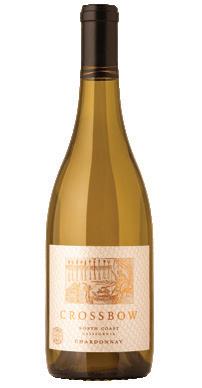
2021 Crossbow Chardonnay North Coast
PAIRS WITH: Smoked Black Cod Dip, Celery Salad & Fried Saltines (page 61). The delicate oak of the wine lets the smokiness of the dip resonate with every sip. A lovely pairing since both the wine and the dip have an inherent richness. Pure indulgence!
be
to claim the newest, highly allocated wines. These are bottles Sunset editors stand behind and serve in their own homes.


2020 Hudson Cabernet Sauvignon Napa Valley
PAIRS WITH: Pipián Rojo–Braised Winter Squash (page 56). A dish that is fullflavored and layered needs a wine that has depth. This Napa Cabernet is laden with dark berries, licorice, cedar, cocoa, and toasty oak notes. The savory braised squash with the spiced mole reveals itself in the same way.
{ OUR PICKS FOR WHAT’S ESSENTIAL IN THE WEST }
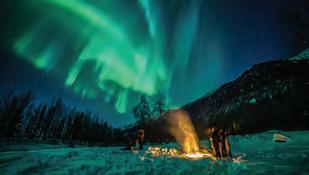
Experience Alaska, Visit Anchorage
Alaska is known for glaciers, wildlife, and natural wonders. Experience it all with a visit to Anchorage. Urban and wild, it offers city comforts and endless outdoor activities. Plan a trip with your free Official Guide to Anchorage VisitAnchorage.net



Explore Egypt like Royalty!
Join the world’s leading archaeologists, including the legendary Dr. Zahi Hawass, on the most extraordinary tour of Egypt. Experience exclusive VIP access to the Great Sphinx, Pyramids of Giza, Luxor temples, and King Tut’s Tomb —completely crowd-free! RoyalEgypt.com

The Living Story of Wine in the West
Each wine we’ve chosen brings the poetry and history of California, Oregon, and Washington into your glass, delivering the best of the West in every box. And each is a moment in time, connected to the land, the growers, and the vintners who brought it to life. Join the Sunset Wine Club to enjoy the best bottles in the West. sunset.com/wineclub

Infusing Flavor. Infusing Happiness.®
Sonoma Syrup Co. is steeped in the region's culinary tradition of naturally derived, high quality and healthful ingredients. Our uniquely American Artisanal Simple Syrups, Extract Blends, and Classic Bar Mixers reflect the exceptional and quintessential flavors of the Wine Country. sonomasyrup.com

Small Ship Cruise Vacations
Experience the beauty and history of the St. Lawrence and Ottawa rivers on a classic Canadian riverboat. 4, 5, 6, 7 night cruises with departures from Kingston, Ottawa, and Quebec City. Call 1.800.267.7868 to request our free travel brochure. stlawrencecruiselines.com

Unbox The West!
The Sunset Subscription Box brings the Best of the West straight to your door! Every three months, you’ll get a box full of home, design, food, and gardening products curated by Sunset editors. Choose the box that fits your style and price point, then get ready to be surprised and delighted by what you find inside! TheSunsetBox.com

ALASKA
101 Explore Fairbanks
102 St Lawrence Cruise Lines EGYPT
103 Archaeological Paths




























Corporation, 9720 Wilshire Blvd. Beverly Hills, CA 90212, Editor, Hugh Garvey, 9720 Wilshire Blvd. Beverly Hills, CA 90212 , Managing Editor, N/A.
S.
S. Media International Corporation, 9720 Wilshire Blvd. Beverly Hills, CA 90212; Michael A. Reinstein, 9720 Wilshire Blvd, Beverly Hills, CA 90212; 11. Known bondholders, mortgages, and other security holders owning or holding 1 percent of more of total amount of bonds, mortgages or other securities: None. 12. Tax status: Has not changed during
TO SUBSCRIBERS In the
If




“SPENDING YOUR POINTS DOES NOT DEPEND SO MUCH ON THE TIME OF YEAR AS WHAT YOU WANT TO ACCOMPLISH.”
expanded to almost a week before and after the major holidays. So we’re seeing higher airfares more protracted over several days, and that just means you’re less likely to get any huge spike in crowds on any given day. The earlier you can book any of your travel arrangements—airline tickets, hotel stays, rental cars, anything associated with your trip—the better. If you’re within three weeks of those holidays, book as soon as possible; typically prices will not go down from there.
Is it better to save your points and miles for something other than holiday travel when fares might be more expensive?
The Points Guy’s leading expert on credit cards and loyalty programs shares tips on planning your holiday travel like a pro.
Interview by KRISTA SIMMONS
For over a decade, Eric Rosen has been completely immersed in the world of travel. The Los Angeles-based globetrotter learned early on how to flex the power of credit cards, points, and miles, eventually leading him to his role as the director of travel content at The Points Guy. Here, he shares his insights on how to maximize your spending and stay savvy during the busy holiday season.
Certain days around the holidays, like the Sunday after Thanksgiving, are notoriously expensive to fly. Any ways to reduce costs when flying around the holidays? In the past, certainly before the pandemic, there were travel days that were always busy: the day before Thanksgiving, the Sunday after Thanksgiving, the weekend before Christmas, and New Year’s Day. Because we are in more of a hybrid, remote work situation, those travel periods have
Spending your points does not depend so much on the time of year as what you want to accomplish. If your goal is flying Emirates first class with Champagne and caviar freeflowing throughout a 13-hour flight, you’re going to want to save up. But keep in mind, airline miles and hotel points never accrue value. They’re always losing their value, so it doesn’t typically pay to hold onto those points and miles for that pie-in-the-sky dream redemption later on. Airline programs are constantly changing how many miles you need to redeem for certain kinds of tickets and increasing the number of miles you need for tickets on their partners. If you find a good use for them in the near term, use them. There’s always a way to rack up more, whether that’s traveling in the future, getting a new credit card, or getting a better handle on your finances and building up miles on everyday spending.
And does the same apply to credit card points?
Credit card points tend to hold their value a little bit better. If you think about something like Amex Membership Rewards or Chase Ultimate Rewards, not only can you transfer them
to a variety of different airline and hotel programs, you can accrue them into a central account and transfer them as needed to the program that you need. But if you want to redeem them directly through the issuer’s own travel portal like Amex Travel or Chase Travel, they tend to have a fixed value per point. That said, airfares are getting higher, hotel rates are getting higher. It’s not worth holding onto a boatload of points for something you’ll book two years in the future when there’s no way of knowing how much those points are going to be worth at that time. The time is now.
What credit cards are the best for when Murphy’s Law of Travel takes place, and you need to utilize travel protections for canceled flights, which often happens around the holiday season?
For my money, I’d say the Chase Sapphire Preferred, or at a higher level, the Chase Sapphire Reserve. Chase Sapphire Preferred, which only has a $95 annual fee, includes things like trip interruption and cancellation insurance for when you can’t take your trip or it gets interrupted and you have some nonrefundable expenses. You don’t actually need to have paid for your whole trip using the card. If you book it as an award and just use the card to pay for the taxes and fees, you can still be eligible.
Any good travel gifts that you’re looking to give this year?
If you have a credit card [whose rewards] reimburse the cost of TSA PreCheck or Global Entry and you already have it, that’s a really awesome gift to give. And then for the on-plane experience, having a noise-canceling set of headphones is a godsend. We love the Bose QCs.
What do you think are the trends that we’re going to be seeing in 2025?
I think we’re going to see airfare stabilize domestically. We are also seeing some truly phenomenal upgrade deals for a couple hundred dollars, even on longer routes. Delta and United are making aggressive upgrade offers, so if you want to treat yourself this holiday season, that’s a great way to do it.
and Chefs of the West are registered trademarks of S. Media International Corporation. No responsibility is assumed for unsolicited submissions. Manuscripts, photographs, and other material submitted to P.O. Box 15688, Beverly Hills, CA 90209 can be acknowledged or returned only if accompanied by a self-addressed,




